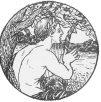*** START OF THE PROJECT GUTENBERG EBOOK 47191 ***
In certain versions of this etext, in certain browsers,
clicking on this symbol  will bring up a larger version of the illustration.
will bring up a larger version of the illustration.
Contents
List of Illustrations
Index:
A,
B,
C,
D,
E,
F,
G,
H,
I,
J,
K,
L,
M,
N,
O,
P,
R,
S,
T,
V,
W,
Y.
(etext transcriber's note) |
{2}

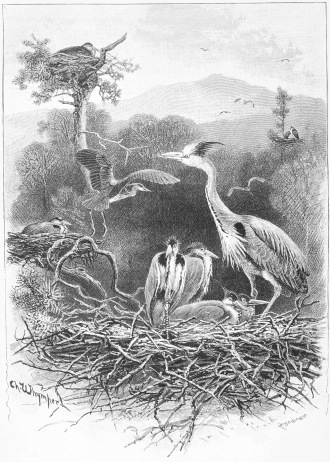 THE HERON’S NEST
THE HERON’S NEST
{4}
{5}
BIRDS OF THE WAVE
AND WOODLAND
BY
PHIL ROBINSON
AUTHOR OF
“NOAH’S ARK” “THE POETS’ BIRDS” ETC.
Illustrated by Charles Whymper
AND OTHERS
LONDON
ISBISTER AND COMPANY LIMITED
15 & 16 TAVISTOCK STREET COVENT GARDEN
1894
{6}
Printed by Ballantyne, Hanson & Co.
London and Edinburgh
{7}
CONTENTS
| CHAPTER_I |
|---|
The Birds of the Seasons—Some Birds of Passage—The Miracle
of Migration—The Thrush—The Blackbird—What is the
Meaning of Singing?—The Swallow | Pp. 11-43 |
| CHAPTER_II |
|---|
The Birds of the Months—Some Rare Birds and Some Common—January
and the Fieldfare—Februrary and the Rook—March,
April, May, with the Thrush, Swallow and Nightingale—The
Terrors of Migration—June and the Ring-dove—A Wood-Pigeon
Problem—The Dotterel—Evening Voices: The Nightjars—July
and the Skylark—August, September, with Grouse
and Partridge—The Ptarmigan—The Old Cock-Pheasant—November
and the Woodcock—December and its Robin and
Wren | Pp. 45-89 |
| CHAPTER_III |
|---|
The Rook—The Cuckoo—Lark and Woodlark—The Sparrow—Plague
of Birds | Pp. 91-110 {8} |
| CHAPTER_IV |
|---|
Bird-Voices—The Corn-crake—The Black-Cap—The Turtle-Dove—Carpenter-Birds—The
Nuthatch—The Wryneck—The Great
Tit—The Letter-Box Tit of Rowfant | Pp. 111-130 |
| CHAPTER_V |
|---|
The Owl—The Magpie—The Kestrel or Windhover—Haunts of the
Heron—Bird-Destroyers, the Gamekeeper and “Naturalist” | Pp. 131-150 |
| CHAPTER_VI |
|---|
The Sea-Eagle—Guillemots—Egg-Gathering—The Paradise of the
Puffins—The Stormy-Petrel—The Sea-Eagle’s Victims—The
Black-Backed Gull—The Skua—Among the Cormorants and
Gulls | Pp. 151-185 |
| CHAPTER_VII |
|---|
The Kingfisher—The Mystery and Folk-Lore of the Halcyon—The
Water-Vole at Home—In the Water-Meadows—The
Moorhen and its Haunts—The Reed-Warbler—The Sedge-Warbler—Music
of the Summer Nights—Waking the Sun | Pp. 187-216 |
{9}
LIST OF ILLUSTRATIONS
| | | Page |
| 1. | “Among the lilacs” | 15 |
| 2. | The Wild Swan | 17 |
| 3. | Mobbing the Great Sea Lantern | 23 |
| 4. | “In days of pinching want” | 28 |
| 5. | “As man’s familiar guests” | 36 |
| 6. | “Waiting for the signal to start” | 41 |
| 7. | Swallows and rain | 43 |
| 8. | Grouse | 47 |
| 9. | “One of the ploughman’s companions” | 51 |
| 10. | “The plovers scatter o’er the heath” | 62 |
| 11. | “The delightful dotterel” | 65 |
| 12. | “Seems to act as timekeeper to the ducks” | 68 |
| 13. | “In the earldom of the Falcon” | 73 |
| 14. | Where the eagle is at home | 77 |
| 15. | The Peregrine | 81 |
| 16. | The old Cock Pheasant | 85 |
| 17. | “Like Snow-birds that are happy without sun” | 87 |
| 18. | Crows at sundown | 94 |
| 19. | “In some brake of fern and bramble” | 100 |
| 20. | House Sparrow | 107 |
| 21. | The Corn-crake and its companions | 115{10} |
| 22. | The Nuthatch at home | 121 |
| 23. | Nesting-hole of Wryneck | 126 |
| 24. | The Tit of Rowfant | 129 |
| 25. | Long-eared Owl | 137 |
| 26. | The Magpie’s fortress | 139 |
| 27. | Where the Kestrels build | 141 |
| 28. | “Enhancing every charm by its transient brilliance” | 145 |
| 29. | The Eagle of the Sea | 155 |
| 30. | Guillemots | 157 |
| 31. | The Sea-Birds’ citadel | 159 |
| 32. | The Sea-Parrots at home | 164 |
| 33. | “Where the sea-folk cluster” | 166 |
| 34. | Petrels resting | 171 |
| 35. | Gulls | 175 |
| 36. | Nest of Lesser Black-backed Gull | 179 |
| 37. | Among the Skuas | 182 |
| 38. | A Colony of Cormorants | 183 |
| 39. | Black-throated Diver | 184 |
| 40. | The King of the Pool | 190 |
| 41. | The cave-haunting Martlet | 194 |
| 42. | “When the ponds are all ice-locked” | 197 |
| 43. | Did I hear some one? | 203 |
| 44. | The Water Hen | 207 |
| 45. | The Reed Musicians | 212 |
{11}
CHAPTER I
The Birds of the Seasons—Some Birds of Passage—The Miracle of
Migration—The Thrush—The Blackbird—What is the meaning of
Singing?—The Swallow
{12}
{13}
CHAPTER I
“And now the goddess bids the birds appear,
Raise all their music and salute the year.”
Wyatt.
“The birds sing many a lovely lay
Of God’s high praise and of their sweet love-tune.”
Spenser.
 IF we had to distribute the Seasons among the birds that
are called “British,” selecting a notable fowl to represent each, we
could hardly overlook the claims of the cuckoo, the nightingale, and the
swallow to distinction. But, after all, these are not “thorough
Britons.” They only come to us for our summer, and when that goes they
follow it. Though great numbers of them are British-born, they are at
best only Anglo-Continental, Anglo-Asiatic, Anglo-African, and
Inter-Oceanic. But our resourceful little islands give us native birds,
all our own, that amply serve the Seasons, and represent, with sufficing
charm, the{14} changing Four. We have the thrush, the blackbird, the
skylark, and the robin, four of the sweetest birds that the round world
can show—
IF we had to distribute the Seasons among the birds that
are called “British,” selecting a notable fowl to represent each, we
could hardly overlook the claims of the cuckoo, the nightingale, and the
swallow to distinction. But, after all, these are not “thorough
Britons.” They only come to us for our summer, and when that goes they
follow it. Though great numbers of them are British-born, they are at
best only Anglo-Continental, Anglo-Asiatic, Anglo-African, and
Inter-Oceanic. But our resourceful little islands give us native birds,
all our own, that amply serve the Seasons, and represent, with sufficing
charm, the{14} changing Four. We have the thrush, the blackbird, the
skylark, and the robin, four of the sweetest birds that the round world
can show—
“The Throstle with his note so true.”
Shakespeare.
“The Mavis mild and mellow.”
Burns.
“A few stars
Were ling’ring in the heavens, while the Thrush
Began calm-throated.”
Keats.
The thrush is pre-eminently our bird of spring. While the snow-drops,
the “Fair Maids of February,” are still in early bloom, and before the
crocus has lit its points of flame or the primrose its pale fires, and
while “the daffodils that come before the swallow dares” are scarcely in
their bud, the thrush has burst forth in full song, its burden the “news
of buds and blossoming.” There is little that is green yet in copse and
hedge: few flowers worth a child’s picking are to be seen. But he is too
full of his glad evangel to be able to keep from singing, and from the
tufted larch
“Rarely pipes the mounted thrush.”
{15}
Some naturalists want us to call it a migrant, and in proof of their
argument, tell us of the multitudes that pass over Heligoland at a
certain time of the year. But against this, let every one who has a
garden where thrushes build, bear witness how, in the hardest winters,
the dead birds are picked up among the laurels, starved or frozen to
death. This alone demolishes the migrant theory. That numbers do leave
England in winter may be true enough; it is the overflow of population.

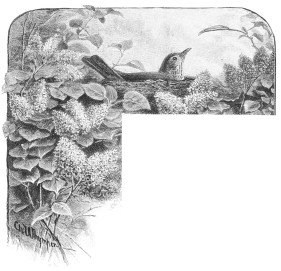 “Among the lilacs”
“Among the lilacs”
Indeed, if the superfluous songsters did not go away (and the Wild
Birds’ Protection Act remained in force), we should be smothered with
thrushes. I know, for instance, of a little “place” in the country, some
thirty acres all{16} told, garden, shrubberies, orchards, spinneys, and
meadow, where birds are tempted to come by the planting of fruit bushes
and strawberry-beds in all directions, by the numbers of elder trees and
mountain ash set out, by the encouragement of blackberries and dog-roses
wherever they can be allowed to grow, and where birds are tempted to
stay in winter by liberal scatterings of grain-foods and table-scraps.
Within this little estate there were one year forty nests of thrush and
blackbird. Now supposing these birds bred only once in the year, which
is very improbable, and reared only three birds apiece, which is equally
so, and that half were killed or died during the year, there would then
be left twice as many thrushes as in the year before. Forty pairs would
become eighty; eighty, a hundred and sixty; a hundred and sixty, three
hundred and twenty, and so on till five years later there would be over
ten thousand pairs of thrushes (allowing all along for the same
excessive proportion of casualties), breeding on thirty acres, and if
each pair hatched five birds, there would be fifty thousand thrushes all
together!
So it is well that thoughtful Nature leads off vast colonies every year.
Those that happen to stop to rest on Heligoland stop there for good and
all, for the Heligolanders eat them. Those that get farther fare no
better, for everybody eats them. Belgian and Dutchman, Frenchman,
Spaniard and Portuguese, German, Swiss, Italian. And it is really a{17}
{18}
{19}

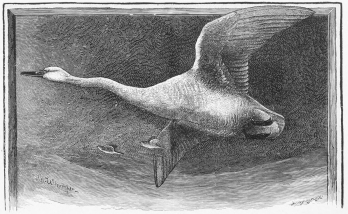 THE WILD SWAN, QUITE AN ISLAND FOR THE LITTLE BIRDS
THE WILD SWAN, QUITE AN ISLAND FOR THE LITTLE BIRDS
mercy that they do. For if all the thrushes that leave us were to come
back again, the consequences would be simply disastrous. Suppose all the
human emigrants from Great Britain were to come back again! The
population of these islands would be sitting three deep on top of one
another.
No, the thrush is not a migrant in the sense that the nightingale is or
the turtle-dove. By a wise dispensation of Nature the superfluous
increment is drafted off annually. But the same number that sing in the
garden in March sing every month in the year till March comes round
again.
There is, I confess it, something very pleasing in the thought that a
particular turtle-dove, all the time that it was enjoying itself in the
palm-gardens by Cairo, or among the arbutus and olives of Athens, should
keep in its memory a particular tree in my garden in England, and in
spite of all temptations should come straight back to it every summer.
For such fidelity I am cordially grateful, and I appreciate the dainty
little bird’s soft purring in the copse all the better for its pretty
compliment of remembrance.
So with the nightingale, that, out of all the whole world, prefers an
old juniper near my house to nest in, and that sits and sings gloriously
every night as if in requital of my hospitality. I am proud of the small
brown bird’s preference for my garden over others, and proud of my
neighbour’s envy, whose garden the nightingale—“dear angel of the
Spring,” “the dearling of the somer’s pryde”—never visits.{20} And I take
care that the rites shall not be violated; that my guests shall never
have cause to regret their choice.
But they cannot stay with us. They come when our daffodils are all
abloom, and go when the roses are fading. It is a far cry from London to
Magdala, but the nightingale goes away even farther than that, and then
in the Spring it turns northward again, and, by-and-by, with myriads of
other birds, comes back to us to find the lilacs in flower, and the
home-staying thrush with young ones already in the nest.
And they come in strange company. Sometimes the wild swan, quite an
island for the little birds, flies winnowing the air beside them;
sometimes a flight of hawks, but with their minds too full of their
journey to think of harming their small fellow-voyagers; always with the
sound of a multitude about them, and the murmuring of innumerable wings.
Pitch dark the night, but somewhere or another is a leader, and they
follow, wild duck and swallow, sea-fowl and dove, broad-winged geese and
tiny gold-crest wrens, an instinct-driven mob that, in spite of all
perils of storm and of distance, keeps its course, with dogged courage,
and steers straight for the land that is to be its summer home.
Lighthouses have become our best observatories for these annual
transits, and the descriptions that are given of the mobbing of the
great sea-lanterns by the hurrying flights of strangely assorted birds,
are so curious as to be scarcely credible. What they suppose it to be,
this bright revolving light in the dark waste,{21} we cannot of course
tell; but they have learned by experience that it means that land is
very near, and so they all swerve in their course to pass through its
rays. And those who keep the lighthouses tell us of the streams of birds
that pass, flashing white for an instant in the glare of the lamp and
then disappearing, and of still larger companies that fly overhead and
out of sight, filling the night-air with the sound of rushing wings and
the clamour of different voices, “feeling for each other in the dark,”
as Bunyan says, “with words.”
“From worlds unknown
The birds of passage transmigrating come;
Unnumbered colonies of foreign wing
At Nature’s summons in bold voyage steer
O’er the wide ocean, through the pathless sky.”
Mallet.
I had been telling a child about the miracle of migration, and when I
had finished, she routed all my science by the simplest of questions,
and utterly posed me by asking: “What do they do it for?” Yes, indeed,
what do they do it for? or what do they do it for? It does not
matter which word we put the emphasis on: it is the same conundrum
always from a slightly different angle; only another turn in the maze.
As the child got no reply, she helped herself to one,{22} and
satisfactorily remarked: “Perhaps they’ve got to.” She had gathered
from my description that there could be nothing agreeable to the birds
in the migration, and, logically enough, since one only does that which
is disagreeable from necessity, she inferred compulsion. But she set me
thinking, and since science attempts no explanation of this appalling
Kismet of the birds, I tried to find a reason for it for myself. And
there can only be this, that it is one of Nature’s methods for reducing
numbers.
At any rate, wherever we turn our eyes in Nature, we find her bringing
forth in vast excess of her requirements, and then restoring the
equilibrium by the institution of active scourges, or terrific epidemics
of suicide. There is no need for the birds to cross seas: to travel
twice a year from the Hebrides to Abyssinia. Do they want a warmer
climate? do they want a cooler? They have only to remain where they are
and change their altitude. Do they need food? The idea is preposterous.
They leave their various countries at seasons when their food is most
abundant; they are then well fed, and are then strongest for the
terrific ordeal before them. Besides, imagine a bird in, say Egypt,
coming to England for food! No, that is the least reasonable of all
explanations. And no other is much better. So we have to fall back on
the child’s reason, “Perhaps they do it because they’ve got to.”
Twice in every year do they start off, these little{23}

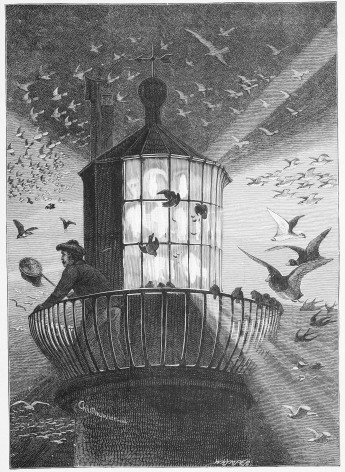 MOBBING THE GREAT SEA LANTERN
MOBBING THE GREAT SEA LANTERN
{24}
{25}
pilgrims, along the broad highways of massacre, walled in, as it were,
with disaster on either side, running the gauntlet of ambush and open
warfare all along the line. The myriads that perish before they reach us
are beyond computation. But the survivors rear new broods, the gaps by
death are all filled by birth, and off they go again once more, giving
hostages to pitiless calamity, and strewing afresh in Autumn the tracks
of Spring with countless corpses. But I did not tell the child this. She
would have said the birds were “stupid,” and thought, perhaps, the less
of them and the worse.
So before we had got home I told her that “perhaps” the reason why the
birds all came to England to build their nests and lay their eggs here,
was because they wanted their young ones to learn the best of manners
and to go to the best of bird-schools. “Some of these birds come from
countries where the people are called savages, because their behaviour
is shocking, and they have no schools, and so (perhaps) the birds come
here because they want the little ones to be nicely brought up.”
It is not much of a reason, I confess. It will not probably satisfy
Professor Ptthmllnsprts. But it satisfied my small companion, for she
approved the conduct of the old birds. And when you can satisfy a child
on a point that you can not satisfy a grown-up person on, you have got
some way, depend upon it, towards the truth. There must be some
advantage{26} in the migration of birds, or it would not happen with such
pitiless regularity. But it does not look as if the advantage were on
the side of the birds.
And now to get back to my thrush. When this bird was first identified
with both throstle and “mavis” is a pretty point that some bird-lover
might care to follow out. It certainly is quite of modern date, for I
find Spenser making the mavis as one bird “reply” to the thrush as
another; in poet-laureate Skelton’s poem the “threstill” is contrasted
with the mavis—“the threstill with her warblynge, the mavis with her
whistell”—and quite as explicitly in Gascoigne. Harrison, again,
clearly distinguishes the two as being different birds. So that the
thrush-throstle-mavis was not a single bird before, at any rate, the
middle of the seventeenth century. And for myself, I should not be
surprised if it were found on inquiry that the mavis was originally the
blackbird, and that it is an old English word, and not a Scotch one, any
more than “merle.” At any rate, this much is certain, that Chaucer’s
English was “a well of English undefiled”; and he sings both of mavis
and of merle as of birds that he knew. And in Chaucer’s day, Scotland
was a fearsome region situated “in foreign parts,” and inhabited by a
race of human beings who only differed from Irish in being worse. And
Chaucer did not speak Scotch. But, as I have said, the origin of our
bird-and-beast names is a very pretty subject still awaiting the
philological naturalist,{27} and when that curious person is forthcoming he
ought to make his subject one of a very curious and lasting interest.
Meanwhile the thrush is with us, year in year out, singing whenever it
can, and persecuting snails in the intervals. For though it is fond of
worms, and dotes on the berries of the mountain-ash, it has a perfect
passion for snails. If a thrush is in a bush in a garden, and you throw
a snail on to the garden path close by it, the thrush is promptly out.
The sound of the shell on the gravel attracts it at once, for it is
familiar with it. In winter, when the snails have all cuddled up
together in some corner behind the flower-pots, or between the pear-tree
stem and the wall, the thrush finds them out, and so long as a snail
remains the thrush will stop. Nor is it a shy bird when thus engaged,
for if you come suddenly upon it, walking quietly on the snow, it will
hop off with its victim a little way and begin again tapping the poor
snail upon a stone, till the little householder is left without a wall
to protect it, and is swallowed. And if a thrush finds a secluded corner
with a convenient stone there, it always takes its snails to the same
spot, building up in its own way a little shell-midden, like those which
prehistoric man has left us, of oyster-shells and clams, to puzzle over.
When driven by stress of weather to the seashore, it treats the
hard-shelled whelks just as it treated the garden-snails, and by
persistent rapping on the rocks, arrives at its food.
By nest, and, above all, by song, this bird is probably{28}

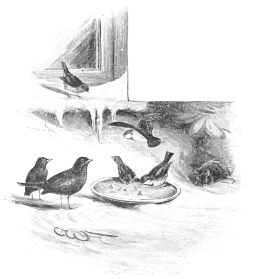 “In days of pinching want”
“In days of pinching want”
the best known of all our birds. The blackbird is quite as familiar by
sight and by song, but many who know what the mavis’ eggs and nests are
like, would perhaps be puzzled to describe the merle’s. The home of the
hedge-sparrow, again, is well known, and, after a fashion, its
appearance; but how many who hear it singing know who the small musician
is? So, taken all round, the thrush is the bird we are most intimate
with. And how welcome it always is on the lawn, with its charming
plumage, and its pretty, half-timid way of coming out into public! “I
hope{29} I am not in the way?” it seems to ask, as it hops quickly out from
under the shrubs, and as suddenly stops. “May I? Thanks.” And out it
hops a little further, and again stops. But why describe so well-known a
favourite? Tennyson has put words to its song, and the better one knows
the bird’s song, the more admirable the poet’s words appear.
And the thrush sings alike, with constantly changing cadences but with
always equal melody, when the wind is blowing bitterly over the
tree-tops, when rain is falling, when the night is dark. In winter the
poor bird, diffident of its welcome, seldom comes to the door for alms
when others come in crowds. So if you have a wish to be kind to it in
its days of pinching want, scatter some food farther from the house, out
of sight of it, and there, if you go cautiously, you may always see the
starved thrushes gratefully accepting their little dues of crumb and
meat.{30}
“The Blackbird whistles down the vale,
How blithe the lay.”
Scott.
“The Merle’s note
Mellifluous, rich, deep toned, fills all the vale
And charms the ravish’d ear.”
Grahame.
The blackbird is the shadow of the thrush: you seldom see or hear one
without the other: nor, indeed, is either of them often mentioned alone.
Yet the blackbird is probably the more commonly seen. For one thing, it
is a very conspicuous bird; for another, it is not so diffident as the
thrush. It is the blackbirds that you see flying out of the cherry-trees
and strawberry-beds, but if you set nets for the marauders, as I did one
year to stock an aviary, you catch quite as many mavises as merles. The
former, it is said, are among the fruit “looking for worms,” but I doubt
it. They are not so bold in their depredations as their black cousins,
but I fancy they are more sly. Blackbirds will fly away with a cherry in
their beaks or a strawberry without any affectation of innocence: the
thrush, when startled, goes off “empty-handed.” But throw down a handful
of fruit, especially raspberries, in an aviary, go aside and watch which
bird is first at the feast—it is the thrush.{31}
The blackbird and thrush are really two birds of very dissimilar
character: the same traps will not succeed as well with one as with the
other, nor is it so easy to rear the former as the latter. Country
people declare that the mothers poison their young ones when caged, and
a poet says:
“The timid blackbird—she, that seen,
Will bear black poisonous berries to her nest,
Lest man should cage her darlings.”
Whatever foundation there may be for the belief, I found that if I caged
a nest of blackbirds (leaving the cage in the bush and the top open for
the parents to go in and out), the old birds would visit the nest,
presumably with food, with the greatest diligence, but the young birds
would be dying in two days. The thrushes kept their young ones alive.
Where do our blackbirds go to? They rear in nearly every case two broods
a year; that is to say, there are every year five times as many
blackbirds as the year before. According to this, starting with a single
pair, a garden ought to have at the end of five years fourteen hundred,
and at the end of ten years, supposing that one half died each year,
something over two million blackbirds. Or, supposing they only rear
one brood, there would be over seven thousand. Suppose the cats eat six
thousand, there would still be the preposterous number of a thousand
left. Where, then, I ask, do all the blackbirds go? It is quite certain
that each pair, as a{32} rule, hatches five birds, yet the number of
blackbirds does not increase. So that if we say there are only ten
thousand pairs of blackbirds in Great Britain, there are at least fifty
thousand killed or made away with every year. “Then, what are they
hatched for?” my child-friend might ask. “For cats” would be my reply.
And yet it seems absurd that a hundred thousand blackbirds should be
hatched every year just for cats to eat. All of which is a mystery to
me.
It is noteworthy of this charming bird that it is an emblem of
cultivation, as the sparrow is of civilisation. Savages only are exempt
from the sparrow: only barren land from the blackbird. As soon as a
garden is laid out, a hedge set, an orchard planted, the blackbird
comes. Except within easy flight of land that man has tended, it is not
found. Its nest, again, has a curious point in its favour, for it is so
well built—being a cup of mud strongly felted with moss and grass both
inside and out—and, as a rule, in such a sheltered spot that it lasts
through the winter, and mice are often glad, when their tenements
underground become uncomfortable, to occupy them. At other times, too,
they serve them admirably for store-rooms and larders. One blackbird’s
nest that I knew of, built into some very dense ivy in an angle of a
wall, was a squirrel’s garden-house; not its regular home, for that was
up in the pine-tree overhead, but a pleasure retreat for empty hours.
But a vagabond rat turned it out, and made a “doss-house” of it.{33}
The blackbird’s song everybody knows, but I have found that only the
closer observers of Nature have noticed how it differs from that of
other birds. Michael Drayton was, I think, the first:
“The woosell that hath a golden bill
As Nature him had mark’t of purpose, t’ let us see
That from all other birds his tune should different be;
For with their vocal sounds they sing to pleasant May,
Upon his dulcet pipe the merle doth only play.”
The old English somewhat obscures the meaning, which is, that while all
other birds “sing” with their throats, the blackbird alone “plays” upon
a pipe. This “dulcet pipe” occurs in other poets, and two or three,
Wordsworth, for instance, speak of “blackbird pipers.” It is almost the
only bird said to “whistle” and to “flute.” The distinction is just, for
it is, I think, the only European songster whose melody so curiously
suggests artificial assistance. No voice is so completely a bird’s voice
as the nightingale’s, but the blackbird, when at its best, is the master
playing on some exquisite instrument. So the ear that has once
distinguished the difference can never mistake the blackbird for the
thrush. It is, too, perhaps the only bird that sings its best in
captivity. There used to be one in an inn in Epping Forest that outsang
all the wild birds within hearing.
Why do caged birds sing, if singing is the expression of happiness and
joy? That human beings should, by the exercise{34} of reason, or the growth
of new interests, by the lapse of time, or the consolations of religion,
recover, after a severe blow, their original serenity and even
light-heartedness, is sufficiently intelligible. But what would the
world say of any bridegroom, torn away from the arms of his bride, and
shut up in a kennel; or of a young father kidnapped in the bosom of his
young family, and ignominiously imprisoned in a fowl-run, who should
straightway behave himself with the utmost gaiety, and exhibit to
passers-by every symptom of happiness? Yet this is what the blackbird,
caught in full song during the pairing season, does. He goes on singing
just as if nothing had happened. It may be, of course, that the brief
days of moping through which the poor bird passes, correspond to long
years of human sorrowing, and that then hope revives, and the blackbird,
remembering how song used to be “once upon a time” associated with all
the joys of home and home-life, thinks that if he only sings long enough
and well enough, they may all come back again. But surely there cannot
be any happiness in that happy-sounding song?
Love-notes of birds are generally unmusical and often grotesque. When
they are pretty they are monosyllabic. So the emotions that prompt
lengthened melody are, as a rule, the sterner and unamiable. Anger,
defiance, pride and possessiveness supply the motives of their songs.
When a lion is amiable, he is quiet; his loudest utterance is a yawn;
when courting, he grunts and hiccoughs; when{35} aggressive or inclined to
assert himself, “just to let Africa know” as it were, he opens upon the
world with the artillery of his voice. Is that the lion’s way of
“singing”? and is the blackbird’s song its way of “roaring”?
To take a more familiar case, it is only when the animal is in the
presence of his own sex, and his intentions are the reverse of friendly,
that the human understanding arrives at the vocal compass of domestic
tom-cats. They then sing melancholy part-songs, out of all time and
tune: we call them “cats’ concerts.” But if you will listen to them, and
not disturb them either by laughter or missiles (as your humour may take
you), you will observe that each cat is “singing” its very best. Very
often no scrimmage results after the music is over, but each cat,
satisfied with its exhibition of its upper register, goes its way. If,
while listening, you can also see the cats while they are singing, you
can have no more doubt as to their own opinion of their performances
than when watching a blackbird. Female cats cannot sing. That fine voice
is an ornament of the male sex alone, and whenever one male meets
another—none of the other sex being present—they at once (if sudden
conflict, giving no time for a “glee,” does not supervene) fall to
singing, each pitting his “g” against the other’s. You may any day see
two such encounterers, having sung their songs, relapse into placid
indifference to each other’s presence, just as blackbirds do, and depart
harmlessly each about his own duties.{36}

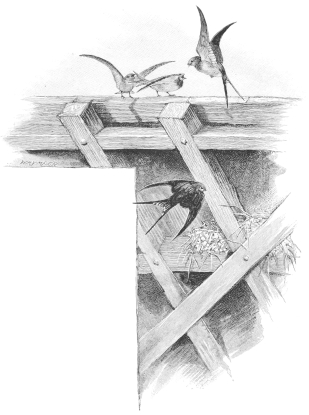 “As man’s familiar guests”
“As man’s familiar guests”
Lions sing much as blackbirds do. Morning and evening they get on to an
eminence and lift up their voices, informing all the other lions in
their parish, and the continents adjoining, that they are going to bed
or have just got up, and that they do not intend to stand any nonsense;
that that particular eminence is their own, and no other lion in Lybia
or thereabouts{37} will be tolerated in its vicinity. If, while one is
roaring, there should come rumbling along on the wind the voice of
another, the vocal duet is prolonged; but when the rites have been duly
performed, “matin-song and vespers eke,” they go about the business of
the day or the night, as the case may be, without further ado.
So, again, in the ferocious old European fighting-days, warriors were
perpetually singing—not love songs, for these were delegated to
professionals and mercenaries, but war-chaunts. Heroes of the Berserker
and hardy Norseman type got up and sang whenever they were excited, as
naturally as blackbirds do, but their singing must have been much more
like the lion’s than the bird’s. Savage races at the present day,
whenever they are unamiably inclined, fall to “singing” war-songs, which
they improvise, music and words alike; and to our ears their
compositions are hideous. So, no doubt, the blackbird would think the
lion’s, and the lion think the blackbird’s. Birds and beasts, no doubt,
differ as much in ear as they do in voice. But reverse their sizes, and
see the result. The emu bellows and booms; there are mice that “sing”
quite prettily. If the lion were the size of a blackbird, he would,
perhaps, as Bottom said, “roar you as gently as any sucking-dove: roar
you as ’twere any nightingale.”{38}
“Swallows obeying the South Summer’s call.”
Keats.
Voice alone does not make a bird a favourite, or what could we say for
the swallow, that has so slight a song, and yet, excepting the robin, is
“privileged above the rest
Of all the birds as man’s familiar guest.”
In the old days Rome loved the swallows as the spirits of dead children
revisiting their homes, and Rhodes welcomed the bird’s return with
public song and canticles of thanks. And long before Rome and Rhodes,
men said that it was the swallow that brought Noah back the leaf; and
the swallow, when Adam and Eve were separated after the Flood, brought
our first parents together again, by telling Adam in Serendib that Eve
was on the Red Sea coast. In later days it is a sacred bird in all four
quarters of Europe: “the bird of consolation” in the North; “bird of the
happy beak” in the South; “the bird of the hearth” in the West; and “the
bird of God” in the East. Apart from all this, “the clime-changing
swallow,” slipt from the secret hand of Providence, that comes all the
way from Southern Africa to hunt our May-flies, is one of the oracles of
Nature and the joyous evangelist of happy Summer.{39}
We all notice the first swallow almost as soon as the first cuckoo; for
though the one bird’s note catches the ear, the flight of the other
arrests the eye as certainly. And what a flight it is! Has it ever been
computed how many hundred miles it flies every day? For hours they are
on the wing, flying at the rate of a mile a minute, and always with
exquisite grace. Watch a bird crossing a hay-field, winding in and out
of the hay-cocks, rising just sufficiently to clear the hedge at the
bottom, wheeling round over the gate, and then up the lane, almost, so
it seems, skimming the ground as it goes, and yet without an effort
lifting itself up over the spinney, and so dropping back into the
hay-field. Their judgment is so accurate that they never have to turn at
an angle, but, always allowing for the curve beforehand, make their
course with a beautifully easy sweep. When there are young ones to feed
their speed is even swifter, their industry more untiring, for instead
of breaking off in their insect hunting to circle in play with their
fellows, or to race the swifts across the sky, they have only the one
idea, to fill their beaks as full as they will hold, and hurry back to
the nest.
The swallow does not go back to its young with a single fly at a time,
but with a mouth filled as full as possible, so that those who try to
calculate the usefulness of this bird by the number of the journeys that
it makes to its nest, underestimate its destruction of insects by
probably fifty per cent. Although, perhaps, few who watch the birds know
it,{40} the swallow’s wide-gaping mouth is sticky inside, so that
everything it catches it holds, and in this way is spared interminable
miles of journeying. To see them at their best is when a hawk passes,
and, for sheer mischief, the swallows chase it.
The hawk is flying, as hawks can fly, with great swiftness; but look at
the velocity of the swallows, which fly round and round the hawk as it
goes! They hover over it, loiter by the side of it, make excursions
ahead of it, and come back, mock it, in fact, as if it were an owl, or
as hares might mock and mob a tortoise. And the hawk never even pretends
to chase one of the swallows, but goes doggedly on its way, as fast as
it can go, to the cover of the wood. To see the swallow at its worst is
upon the ground: there it is a poor thing indeed, and from the shortness
of its legs and the length of its wings, has to shuffle along, rather
than walk.
But it does not often condescend to walk on the ground. When it alights,
to knead the plaster for its nest at a puddle’s edge, or for any other
purpose, it springs up into the air from the spot on which it settled.
And its nest once built, it has no reason for coming to the ground at
all. It does so from choice sometimes, where it suspects insects are
congregated, or sometimes to drink, but, as a rule, it both eats and
drinks on the wing. When it rests, it is on a house-roof, a railing, or
dead branch, and often when thus seated it sings a very sweet, simple
little song, loud enough to puzzle the passer-by, who can hear but not
see the{41} songster, and pretty enough to astonish those who imagine that
swallows only twitter.

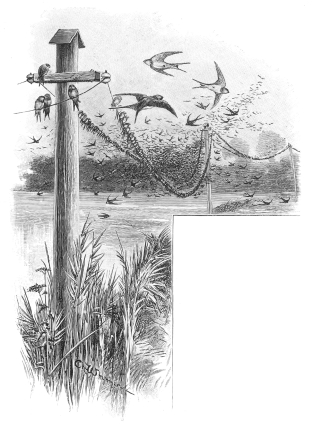 “Waiting for the signal to start”
“Waiting for the signal to start”
While the hen-bird is brooding she is busily fed by her mate, and the
compliments that pass whenever the two birds meet are very sweet to
listen to.{42}
Every time he comes there is a scrap of conversation, and when she has
eaten what he has brought, there is a little exchange of twittered
love-nothings. There are always two broods in the year, the first
scattering over the country and eventually straggling away in small
migratory parties across the sea, the second going with their parents in
the great annual exodus in October.
It is then that these birds congregate in vast companies, lining the
telegraph-wires for miles, till they loop with their weight, or crowding
upon every available foothold of some range of buildings. How
irresistible the discipline of these little creatures is, as you look at
them sitting there by the thousand, waiting for the signal to start on a
journey the object and end of which is a mystery to all the young ones.
You will see how impatient they are, how they keep on trying their wings
by wheeling round in the air. With what restlessness they take short
flights and resettle. And all this time, and up to the very last, the
old ones keep on busily feeding the young, as if they knew what a trial
was before them, and how urgent their need of all the strength possible.
Here and there are broods hatched too young to join in the great Hegira,
and here and there nestlings with some infirmity that unfits them for
boisterous travel. These are found lingering in our islands all through
October into November, but the great army of the swallows musters at the
rendezvous punctually to date. And there they sit in their myriads, but
the whole{43} obedient as one, and lo! next morning, before the sun is up,
they are gone, every one of them—gone towards the sea, towards the Nile
and the Cape, gone till next Spring. For
“the year is overgrown,
Summer like a bird hath flown.”
{44}
{45}
CHAPTER II
The Birds of the Months—Some Rare Birds and some Common—January and
the Fieldfare—February and the Rook—March, April, May, with the
Thrush, Swallow and Nightingale—The Terrors of Migration—June and the
Ring-dove—A Wood-pigeon Problem—The Dotterel—Evening Voices: The
Night-jars—July and the Skylark—August, September, with Grouse and
Partridge—The Ptarmigan—The old Cock-pheasant—November and the
Woodcock—December with its Robin and Wren
{46}
{47}
CHAPTER II
“Kirchup! Kirchup! among the wheats
Partridge distant partridge greets,
Beckoning hints to those that roam
That guide the squandered cover home.”
Clare.
IT is easy, taking a score of birds, to construct a bird-calendar, a
zodiac of birds, that comes very near the actual truths, and almost
exhausts the list of more notable land-fowl. There are some, like the
heron or the bittern, the curlew, the woodpecker, or the coot, that are
not significant{48} of any particular time and season, because they are not
sufficiently familiar.
It is only by some fortunate accident and in particular places that you
may hear the lonely cry of
“the heron as he spreads his wing,
By twilight o’er a haunted spring;”
or the bittern
“bellowing harsh,
To its dark bottom shake the shuddering marsh.”
It is a very quaint and ancient myth that the “mire-dromble” or
“mere-drum” fixed its beak in a hollow reed or in the bog, and by
“snoring,” “booming,” or “bellowing” through it made, as Burns says,
“the quagmire reel.” Several poets refer to the bittern “shaking the
solid ground,” Thomson among them, in the absurd lines, “The bittern
knows his time, with bill ingulpht, to shake the surrounding marsh.” But
they are all to be traced back to Michael Drayton’s description of how
“The buzzing bitter sits, while through his hollow bill
A sudden bellowing sounds, which many times doth fill
The neighbouring marsh with noise, as though a bull did roar.”
It is altogether a delightful bird in poetry and folk-lore, this
“bog-bumper” or “betowre,” or whatever name we choose{49} to know it by.
The curlew again, a bird of the coast and the northern uplands, is
familiar only to those who live near marsh and moor, though its weird,
wild clamour, as it passes overhead in the night, is the source of a
superstition, which, as “Gabriel’s hounds,” “The Seven Whistlers,” “The
Wild Huntsman,” is common to all Northern Europe, and is probably the
origin of that fearful wild-fowl that was the “trump of doleful drere,”
“the whistler shrill that whoso hears doth die,” to which Wordsworth
alludes:
“He the seven birds hath seen that never part,
Seen the seven whistlers in their nightly rounds,
And counted them;”
and Moore:
“Oh! did you hear a voice of death?
And did you not mark a paly form,
Which rode on the silver mist of the heath,
And sang a ghostly dirge in the storm?”
All this, and ever so much more of quaint and interesting tradition, has
its source in the impressive uncanny cries with which the curlews,
flying by night, keep their company all safely together. The woodpecker
again, Tennyson’s “garnet-headed yaffingale,” the bird of Picus the
augur, which breaks with his crazy ringing laugh so suddenly upon the
solitude, is familiar only to those who live near woods. Marvel has some
excellent but little-known lines on the “hewel,” as he calls this bird
of many aliases:{50}
“He walks still upright from the root,
Measuring the timber with his foot,
And all the way to keep it clean
Doth from the bark the wood-moths glean.
He with his beak examines well
Which fit to stand and which to fell.
The good he numbers up and tracks,
As if he marked them with an axe;
And when he, tinkling with his beak,
Doth find the hollow out to speak,
That for his building he designs,
And through the tainted hide he mines.”
The coot, too, is a bird only familiar to such as dwell near quiet
waters—a whimsical and odd-mannered amphibian, that gives a very
pleasing animation to the sequestered places it frequents, for whether
diving and ducking in the water, or moving with flicking tail about the
banks, in that “jerky, high-stepping manner” which Dudley Warner
disliked so delightfully in his neighbours’ hens, it is a fowl of
pantomimic behaviour that is very diverting to watch.
Other birds, again, are too common to be significant of time or of
season, though, among them are many of the most popular of our feathered
folk—the beautiful and merry chaffinch, the roadside yellowhammer, the
linnets that are everywhere, the delightful goldfinch and bullfinch, the
sweet-song hedge-sparrow, the handsome monotonous greenfinch, the
ubiquitous sparrow—“meanest of the feathered race,” as Cowper unkindly
calls it—and the dainty water-wagtails that{51}

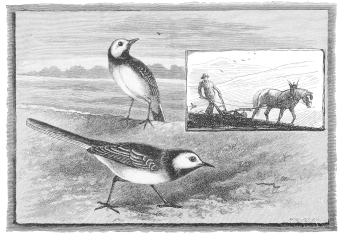 “One of the ploughman’s companions”
“One of the ploughman’s companions”
{52}
{53}
everybody likes. Some of the wagtails stay with us all the year round,
but most move southward as winter approaches, and when the weather
becomes severe, cross the Channel to seek a warmer climate. In Spring
they are one of the ploughman’s companions, for often it is only in the
freshly-turned furrows that they can then find the insect food they
need, but later on they seek the neighbourhood of water where winged
things assemble, and there love to paddle in the shallows. Often, too,
they take flights inland, searching the meadows and garden-lawns for
“such small deer” as they live upon, hawking for flies among the
haycocks or amongst the cattle that are standing at ease by the pond, or
following them in quest of the insects which, as they graze, they
disturb from the herbage. I know no bird that is more “bird-like” than
the wagtail; more dainty, delicate, and elegant: in its every movement
it is airy, the embodiment of buoyant grace: whether on the ground or
a-wing it is fairy-like, volatile, and wayward: running, fluttering, and
flitting impulsively as if it were too happy to stop to think, like a
child in a meadow full of flowers: a sylph among the birds, so slim and
so sweetly-proportioned as to make its little companions look burly and
thick-set: so prettily timid in its demeanour that the rest seem almost
aggressive; in a word, a bird of birds.
But between the familiar and unfamiliar there are just enough birds,
well known to all of us, that fit the seasons and the months with a
rather special appropriateness.{54} For the months there is the fieldfare
for January, the rook for February, the thrush for March, the swallow
for April, the nightingale for May, the dove for June, the kingfisher
for July, the grouse for August, the partridge for September, the
pheasant for October, the woodcock for November, and “the wren, the
wren, the king o’ the birds,” for December.
“A Winter such as when birds die
In the deep forests.”
Shelley.
“Now various birds in melting concert sing,
And hail the beauty of the opening Spring.”
Savage.
The fieldfares comes to us late in the year, and in January, if the
weather be very hard, are often the most conspicuous wild birds of the
month. Most people mistake them for missel-thrushes, as they travel
about in companies over the snow-covered fields, ransacking the hedges
in such methodical fashion for the hawthorn berries, or scattering over
open patches of ground in quest of seeds or insects. This mistake,
doubtless, saves many of their lives, for those who would not shoot our
native missel-thrushes in the snow, might have no compunction in bagging
the strangers from abroad, who bring{55} with them such a reputation for
the table as the fieldfares, and who, it might be urged, are poaching on
the scanty winter-provisions of thrush and blackbird—“the hawthorn’s
berries red, with which the fieldfare, wintry guest, is fed,” and which,
if it had stayed at home, would help to keep our own song-birds alive
through the pinch of the year.
In February the rooks have repossessed themselves of their old haunts:
“His airy nursery in the neighbouring elm
Constructs the social rook, and makes the grove
That girds the crumbling edifice around,
And every angle of its ruined pile,
With the bass note of his harsh love resound.
Hurdis.
“Lofty elms and venerable oaks
Invite the rook, who high amid the boughs
In early Spring his airy nursery builds,
And ceaseless caws amusive.”
Thomson.
“Soothed by the genial warmth, the cawing rook
Anticipates the Spring, selects her mate,
Haunts her tall nest-trees, and with sedulous care
Repairs her wicker eyrie tempest-torn.”
Gilbert White.
And so to March and “the throstle with his note so true”; and April,
when “the swallow knows her time, and on the vernal breezes wings her
way, o’er mountain, plain, and far-extending seas, from Afric’s torrid
sands to Britain’s shore, before the cuckoo”; and May, “with the darling
of the{56} Summer’s pride, fair Philomel,” “the dear good angel of the
Spring, the nightingale,” and
“All vital things that wake to bring
News of buds and blossoming.”
With the swallow and the nightingale, many other birds “transmigrating
come, unnumbered colonies on foreign wing, at Nature’s summons.”
From every quarter the aliens, if birds bred on British soil by
British-born parents can be called such, converge upon our coasts, just
as if England were the centre of a circle at which all the birds who
spend the rest of the year upon its circumference congregate for the
nesting season, reaching the same point at the same time, but
travelling, each company, on a radius of its own.
I have often wondered that migration is not more often looked at through
the other end of the telescope, and Great Britain called the “home,” for
instance, of the nightingale. What makes “home” for a bird? Is it not
the place where the nest is built and the young are reared? For the rest
of the year the families travel “abroad,” returning “home” for all that
makes life important and domestic. Their fixed addresses are in England,
their names are in British directories as residing there. But their
doctors will not let them winter “at home,” and so they have to go on to
the Continent, or to even warmer latitudes, for the colder months{57} of
the year. I myself entertain, and often express, a grudge against the
“migrants” for staying only so long as it is fine; but as often as I do
so, my conscience reproaches me, for, after all, the nightingale shows
its affection for its birthplace by coming back to it; and, “in spite of
all temptations to belong to other nations,” remains a true-born English
bird. What more could it do? It might certainly stay and freeze to
death. But why should we expect nightingales to do more than we expect
men and women to do? Which of us, if warned by doctors against the
English winter and possessing the means to go abroad, would stop at home
to die here, just to show that we are lovers of our country? So it would
be quite in keeping with the sympathetic and kindly tendency of
contemporary natural history, if we looked upon the birds when they
come, as our own birds coming home, and when they go, as going abroad
under the inexorable compulsion of health; if we welcomed them in Spring
as returning fellow-countrymen, and bade them god-speed in Autumn, as
delicate folk who would, if they could, but dare not, stop in Britain
all the year round. And who can blame the birds, apart from necessities
of life and death, for leaving our shores? Think of the climate they can
always, by a morning’s flight, enjoy, year in and year out, “in foreign
countries”; what range of space, what perennial abundance of food, and
then calculate the force of inherited affection for the place of their
birth that urges them, hosts of little feeble people, to dare the{58}
appalling journey “home,” to risk the truly awful perils of return to
their native land. Had they human intelligence, and did they live by
reason, not one of them would think of coming here.
What human parents would think of wintering in, say, Cairo, if they knew
that the railway companies meant to destroy them wholesale as they
travelled down to Dover; that the coast-guard and along-shore rabble
were all on the look-out for them to take their lives; that the Channel
steamer owners were in conspiracy to kill them; that the quays at Calais
were swarming with avowed murderers of British travellers; that every
Continental line was run by bandits and brigands sworn to shed their
blood, and every hotel and resting-place an ambush of assassins? What
British pater-familias would “winter in Cairo” under such conditions of
travel? Yet these are the conditions under which the nightingales come
and go. Only they do not know it. If they did, “the instinct of
self-preservation” would surely triumph over “love of country,” and we
should never see any nightingales in England, nor any turtle-doves—one
of the most beautiful of our birds. But more of turtle-doves by-and-by.{59}
“The Ring-dove in the embowering ivy yet
Keeps up her love lament.”
Shelley.
“Summer hath spoken soothingly to each nested Finch.”
Keats.
Their larger and more beautiful relative the ring-dove or wood-pigeon we
have with us always, and I think it is conspicuously the bird of June.
The young are then on the wing, and it is impossible, passing near their
haunts, not to be attracted by this ornamental bird, which, whether
flying or at rest, adds a grace to every scene. Above all, it is
beautiful when it beats its way up into the air to a height, and then,
expanding its wings, comes floating down again. This exquisite
performance may be seen at almost any time, for the ring-dove sometimes
has three broods in the year, and if, as is supposed, it is a part of
the bird’s courtship, is as appropriate in October as in March. Both
birds may sometimes be seen executing this graceful “manœuvre”
together; and it is, I think, the most prettily significant of all
bird-gestures. Throughout June may be heard “the deep mellow crush of
the wood-pigeon’s note, making music that sweetens the calm” of the
summer woodlands or the sudden clapping when the startled bird,{60} “on
loud-applauding wing,” quits its perch. Hardly a country walk can then
be taken without seeing, either feeding on the ground, at rest, or on
watch upon the trees or flying overhead, the handsome bird, in its
plumage of lavender-blue, that seems so wild, and yet can be tamed
sooner almost than any bird but the robin.
It is an odd fact that the civilised sparrow, the most coolly familiar
of birds, is the most difficult to make tame. The fact is, it is
naturally vulgar, and no gentle influences can ameliorate the naturally
vulgar. When at liberty, it will take all the liberties it can and
dares; when shut up, even if from the nest, it develops into a voracious
idiot; never amenable to kindness, always ferocious for food.
Yet the wood-pigeon, one of the wildest and shyest of birds, will soon
become tame, will feed from the hand, and when the miserable, suspicious
sparrow rushes into hiding, will sit in the aviary unconcerned and
confident of friendship.
But note this curious difference. The sparrow in an aviary will breed,
lay its eggs, and bring up its young ones, without any difficulty. The
ring-dove may walk about at nesting-time with twigs in its mouth, may
lay eggs, but let the aviary be never so large, it will not hatch its
eggs.
This contradiction in character is very extraordinary, and yet, if
considered, there is no irregularity in it. The sparrow builds simply
because it will build anywhere, and is{61} accustomed to the neighbourhood
of men. But it never becomes in the least friendly: never even lays
aside a suspicion which would be unbecoming in a Central African finch.
The ring-dove, on the other hand, recognises at once a benevolent
intention, becomes quite tame, and yet, during the nesting-season,
cannot accommodate itself to conditions so outrageous to its nature. For
it loves to build its platform in the most secluded spots, not always
far from human habitation, but as far as possible out of sight.
Again, in protecting its young, this timid bird becomes very bold. I
remember taking a young cushat from a tree and trying to rear it by
hand, but it was almost full-grown, well-feathered, and too old for the
purpose. After two days’ very unsuccessful experiments, I took it out on
the lawn in a basket, on the chance of its parents being about, and the
result was certainly as surprising as it was unlooked-for. The young
bird, when we had all retired, began to show signs of excitement,
stretching its neck up, and looking all round it vaguely; then it
perched on the rim of the basket, and thoroughly searched the tree-tops,
and all of a sudden it either saw or heard something that we did not,
for it brightened up, stretched its neck to the utmost, looking
excitedly in a particular direction, and then flew its first flight,
heavily, but straight, to the top of an arbour. Scarcely had its feet
touched the roof when, as if by magic, one of the old birds appeared at
its side and began at once{62} to feed it. None of us stirred, and, as soon
as the meal was finished, the old bird hopped up to an overhanging
branch, the young one following, and so up into the tree, and from that
one to the next, and the next, till, in a few minutes, it had travelled
along the tree-tops a hundred yards away. Now, the old birds must have
been waiting about the house all the two days, for it is hardly likely
that the taking out of the young one on to the lawn could have
accidentally coincided with the coming of the old one to the same spot.

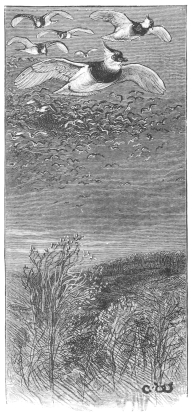 “The plovers scatter o’er the heath”
“The plovers scatter o’er the heath”
{63}
However, it is a curious, and really baffling, commentary on the whole
incident that thereafter two old wood-pigeons and a young one, before
the household was up in the morning, and off and on during the day, used
to come down upon the lawn and examine the spot where the captive’s
basket had stood, and which, after the young bird’s flight, we had
shaken out on the spot, scattering all the peas and food that was in it
upon the grass. Every day a handful of crumbs or maize used to be thrown
there, and every day the family came for it. By what process of
“instinct” could wild birds be led to behave so unreasonably? Did they
separate in their “minds” the incidents of capture and of release, and
being unable to put one and one together, consider the latter as an
isolated act of benevolence apart from, and quite unconnected with, the
former, and so behave with gratitude in consequence? Did they look on us
only as the good Jack Stout who pulled Pussy out, forgetting that we
were also the naughty Tommy Green who put Pussy in? But the workings of
“instinct” are not to be followed out by “reason,” or what shall we say
of all the other birds who, until we find their nests, are full of
artifice to mislead us, and apparently most anxious that their secret
should not be known, but who, once their nest is found, appear to lose
all concern about the matter, and move to and fro as if it were the most
natural thing in the world to treat us with confidence and be thoroughly
aboveboard with us?{64}
Take the delightful dotterel, for instance. It will go through all the
deceptive performances of a lapwing, and weary out your patience with
anxious devices for leading you astray; and yet, when you at last
discover its beautiful eggs, olive, with rich dark markings, or its
downy little ones, almost the same colour as the eggs, cuddled together
in a small hollow, the old birds seem almost to congratulate you upon
your sagacity, and come close, as much as to say, “Yes, these are our
eggs; we were trying to show them to you all the time; and this is the
way we sit down on them. Like to see us catch a fly? There! That’s the
way we do it. See us run.” Then they droop one wing and begin to flutter
along the ground, as if hurt—just to show you how it is done; and, in
fact, before you go (and over your going they unreservedly and
unmistakably rejoice), will sometimes go through such a series of
performances as justifies their proverbial reputation for semi-idiotcy:
“The dotterell which we think a very dainty dish,
Whose taking makes such sport as man no more could wish,
For as you creep or cower, or lie or stoop, or go,
So marking you with care, the apish bird doth so,
And acting everything doth never mark the net
Till he be in the snare which men for him have set.”
This was written three centuries ago; but foolish or not, the dotterel
is a very engaging little bird, and to those who live near its summer
haunts one of the prettiest details of bird-life{65}

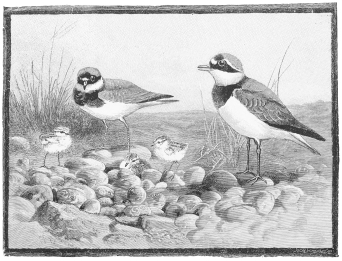 “THE DELIGHTFUL DOTTEREL”
“THE DELIGHTFUL DOTTEREL”
{66}
{67}
in June. Long after dusk, its plaintive note can be heard, now here, now
there, among the tussocked grass, as the birds reply to one another from
their sleeping-places. And the mist comes creeping up on to the moorland
from the reedy mere beyond, and in the distance may be heard the voices
of the water-birds settling down for the night among the plumy sedges,
where the grey heron, perched upon the skeleton of some water-logged
boat, seems to act as timekeeper to the ducks and widgeon that live hard
by, and are under orders to be “within doors” by nightfall.
Listening to the twilight voices of birds, the most notable by far, that
which holds the attention longest, though it may not be the first to
catch the ear, is the fern-owl, whirring to his mate as she hawks
backwards and forwards over the undergrowth, and turning in the air as
she flies with queer sweep of the wings. Where there is one pair there
are generally more, and the sound seems continuous, one bird taking it
up from the other, or more than one “churring” at the same time. No bird
of its size performs more curious antics on the wing than the “nightjar”
or “goatsucker,” and it is almost incredible that the creature, flapping
and tumbling in such ungainly fashion through the air, when startled
from its sleeping-place in the day-time, is the same that one sees
sailing and sliding so gracefully after nightfall.
{68}I know a beautiful orchard where these birds haunt,

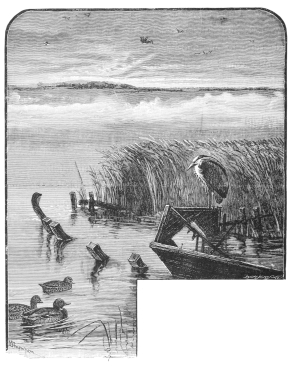 “Seems to act as timekeeper to the ducks”
“Seems to act as timekeeper to the ducks”
and have often seen them lie crouched along the boughs, cowering so
close that one day, going to sling a hammock, I nearly put my hand upon
the bird. It slipped off the bough and, with a flight like a woodcock’s,
sawing from right to left, it swooped under some gooseberry-bushes and
vanished from sight. In the day-time{69}, this power of sudden
disappearance is the poor fern-owl’s chief protection from its
persecutors, for, starting as if for long flight, it drops upon the
ground with a single instantaneous movement, and where it drops there it
lies quite motionless—and everybody overruns the spot. Its wonderfully
beautiful colouring fortunately assimilates both with the bark of trees
and the bare ground, and the cleverest of dogs will overshoot it without
discovery. If flushed a second time, it as often as not flies back to
the spot, or near it, where it was first startled. At night, when it is
feeding, coursing up and down above the heather and the brackens, it has
a beautiful flight, and should an owl suddenly drop over the birches and
begin to beat their ground, the evolutions of the nightjars in silent
protest are as exquisite as any sea-bird’s.
To July belongs the skylark, a bird really of all the year, but most
intimately somehow the genius of the meadow. The hay has been cut, the
first brood of young are flown, and the larks are again building,
renewing the Spring with the aftermath of grass. The glorious growth of
the meadow, spangled with ox-eye daisy and corn-flower, has been laid
low, and the scented harvest has been carted, and the larks are busier
than ever in the smooth-shorn field, while the sky seems never so full
of their song as when the hay-makers are afield. The scythe and the
terrible machine, and the tramp of feet behind them, are fatal to many a
brood,{70} but the majority escape, being on the wing, or, at any rate,
running with their parents safely out of danger, by the time that the
mowers come.
“And the glossy finches chatter
Up and down, up and down,
And the chaffinch idly sitteth
With her mate upon the sheaves,
And the wistful robin flitteth
Over beds of yellow leaves.”
“The Moorcock springs on whirring wings
Among the blooming heather.”
Burns.
August is, by sad right, the month of the grouse—a month of
catastrophe, for it is then in the best of its health, enjoying the best
of the moor and harvest, when the fateful Twelfth comes round; and after
the day is over, horrid with perpetual guns,
“at the close of eve
She gathers in, mournful, her brood dispersed
By murderous sport, and o’er the remnant spreads
Fondly her wings.”
It is now, too, that the ptarmigan collect into large parties,{71} and,
forsaking the highlands, wander lower in search of more varied food:
unwise in their generation, for in the higher altitudes they were
comparatively safe from many of the perils that beset the grouse. True,
when they were up among the clouds they were in the demesnes of the
eagle, who thinned their company as they fed upon the shoots of heather
and ling growing in tufts among the rocks or in broad patches down some
sunny slope—
“Where the grouse lead their coveys
Thro’ the heather to feed.”
How silently and swiftly the birds of prey come wheeling round the curve
of the cliff, and, skimming the ground, pick up and carry off one of a
covey before even its companions can collect their wits to raise an
alarm. So in India I have seen the laggar falcon take up a quail and
pass on like some shadow, without disturbing the rest, as silent,
literally, as the wind, and with an incredible speed. Yet to watch an
eagle beating round the base of a hill there seems too much
leisureliness for speed. But time its flight, and you will find that
though the beats of its wings seem at long intervals it is really going
by with great velocity. Its home, and its favourite watchtower, for
birds of prey have always some one spot to which, when they wish to be
idle, they find their way, is some lofty crag. There seated aloft, they
overlook the lowlands where{72} they find their food, without danger of
molestation while in repose. For it is always up on the peaks, sometimes
looking seaward over the nations of the sea-fowl, but generally inland,
where, when the clouds leave it an unbroken prospect, it can sit, like
some fierce old warden of the marches, to control the tribes of the
valley. It feeds by choice upon lambs, on fawns and hares; so that,
though the ptarmigan and grouse pay tribute, they are not harried by the
eagle.
When they wander lower down the slopes the game-birds come within the
earldom of the falcon, the peregrine, a terrible bird, as fierce as it
is swift, and for ever ranging the moors in quest of food. I have known
it, in India, chase its quarry right among the tents of the camp, kill
it within a few feet of the tethered horses and their attendants, and
carry off its prey before there was sense enough among the onlookers to
snatch up a gun. When trained they are still as highly prized as of old
in England, and at Dholpur I have seen it flown, from the hand, at both
egret and duck, and marvelled, the last time as much as the first, at
the terrific velocity of its swoop. It seems, too, as if the bird struck
its prey with its beak, whereas it always strikes with its talons,
striking and clutching almost simultaneously. The fearful impact breaks
the quarry’s back, and enables the falcon, if it chooses, to continue
its flight with the dead bird in its grasp, without coming to the ground
at all.
In England, owing to increased cultivation and the enclosure{73}

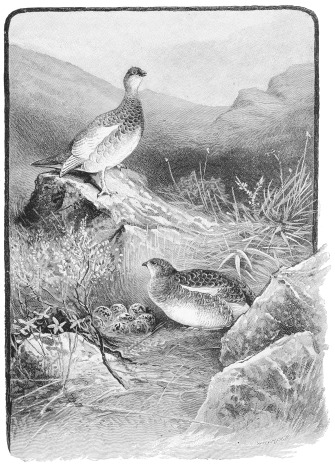 “IN THE EARLDOM OF THE FALCON”
“IN THE EARLDOM OF THE FALCON”
{74}
{75}
of land, falconry is virtually an extinct form of sport, and the few
rich men who still keep the flame alive have mitigated the horrors which
aroused the indignation of Gifford. “Humanity,” says he, “has seldom
obtained a greater triumph than in the abolition of this execrable
pursuit.” ... “The blood runs cold while we peruse the calm instructions
of the brutal falconer, to impale, tie down, fasten by the beak, break
the legs and wings of living pigeons, herns and herons, for the hourly
exercise of the hawk, who was thus enabled to pull them to pieces
without resistance.”
At one time, being protected, all “British” hawks were common in
England, and showed no more fear of man than they do at the present day
in India. Indeed, they seemed to display rather a preference for his
neighbourhood, following him when in the field, breeding familiarly in
buildings, and making dove-cots and poultry-yards their feeding-ground.
But now, having learned by a couple of centuries of persecution that
they have become unpopular, the hawks avoid humanity and all its ways.
Even the common species keep out of sight as much as possible, and some
have left the country altogether, or retired to the wildest portions of
the islands. The peregrine, for instance, is found at times only here
and there in Scotland—and occasionally on cliffs on the Cornish, Welsh,
or Cumbrian coasts—and its eyrie is there, as a rule, in the midst of
the most desolate scenery. Like the eagle, it has its favourite{76} “post
of observation,” and when full-fed and at its ease loves to bask there,
and from its elevated seat survey the proceedings of the dwellers at
meaner altitudes, upon whom it makes regular forays, and who, strange to
say, seem to submit to this assertion of manorial rights with the
minimum of protest and disturbance—very much like the unfortunate
villeins and vassals in “the good old feudal days” of baronial England.
Ah, nut-brown Partridges! Ah, brilliant Pheasants!
Byron.
September is, of course, by long prescription, the partridge’s month,
and October the pheasant’s, than which there are no two birds probably
in all England that invest a country scene with a more immediate
interest and charm. In a certain field through which I used often to
pass in the evening, there used to be near a gate a large square patch
of ground upon which the farmer had once stacked manure, and the hay
never grew on it, only a wonderful crop of chickweed and plantain, with
fumitory and other weeds. And every evening, if I walked carefully, I
could surprise the partridges with their young brood busy after food on
this open plot. As the fancy took them, they would be alarmed by my{77}

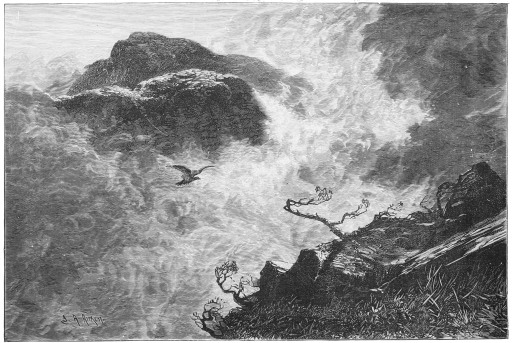 WHERE THE EAGLE IS AT HOME
WHERE THE EAGLE IS AT HOME
{78}
{79}
approach, vanishing through the surrounding wall of tall meadow-grass in
a twinkling, or they would cluck and crane their necks to look at me,
and then go on feeding—all except the cock-bird, who invariably fled,
and from his hiding-place would keep on making nervous remarks to his
wife, who kept as regularly reassuring him with little comfortable
clucks that all was right. A little scattered chicken-food brought them
very soon through the gate into the garden, and from the garden on to
the terrace, where they came at last to feed as regularly and happily as
ordinary pigeons. But when September came, and the guns were busy in the
farmers’ fields that lay outside their garden-asylum, the covey
gradually dwindled away till, out of the nine, only four survived the
season. The pheasants, too, were free of the grounds, and they were
always in evidence. The carnations had all to be fenced in wherever
growing, for the pheasants would not leave them alone, and they were
very fond, too, of parading along the wall, and pecking off all the
jessamine buds and tips they could reach; but with jessamine we could
afford to be liberal, and the birds were allowed to eat all they could.
Not all that they would though. For one day, while sitting in a
greenhouse, I saw an old cock, the most absurdly vain old bird
imaginable, fall off the wall. He tried to reach a tuft of jessamine
that was exactly impossible, and after many half tumbles and recoveries
of balance with much wing-flapping, he at last made one more desperate{80}
effort, just a little more desperate than before, and just too much for
his balance, for down he came with a kind of somersault into the garden.
And to see him on the ground, how he shook himself and looked round; how
affronted he was, and how pompous! If he walked stiffly before, he was
now positively on wires. If haughty in demeanour at all times, he was
now as superciliously superb as Tamburlane. He moved, like Shakespeare’s
peacock, with “a stride and a stand,” the very personification of
magnificence embarrassed. And in obedience to his call the two hens, who
had been staring from the top of the wall, astonished at the sudden
falling-off in stateliness of their dandified emperor, flew down, and he
led them off, loftily explaining as he went his reasons for his new
method of getting down from a wall, and the advantages that the
intelligent derived from such originalities of procedure.{81}


“Firm on her perch
Her ancient and accustom’d seat, she sits
With wing-couched head.”
Grahame.
{82}
{83}
“When first the vales the Bittern fills
Or the first Woodcock roams the moonlit hills.”
Wordsworth.
“Beside the Redbreast’s note, one other strain,
One summer strain, in wintry days is heard—
Amid the leafless thorns the merry Wren
Pipes her perennial lay.”
Bloomfield.
“Of various plume and chirp the shiv’ring birds
Alight on hedge or bush, where late concealed
Their nests now hang apparent to the view.”
Grahame.
To November we ought to give the woodcock, the aristocrat among our
winter visitors. To see one in a winter’s walk makes the walk memorable;
we speak for ever so long afterwards of “the day we saw that woodcock.”
An old book says: “Of woodcocks especially, it is remarkable that upon a
change of the wind to the east, about Allhallows-tide, they will seem to
have come all in a night; for though the former day none are to be
found, yet the next morning they will be in every bush.” This was three
hundred years ago, and woodcocks are not now to be found “in every
bush,” even though the wind (as it too often is) be east “about
Allhallows-tide,” although that “they seem to have come all in a night”
is{84} strictly true, as woodcocks migrate by night, and guns out one day
in October that have not flushed a single cock, will the next day make a
bag. At one time the bird was so common that weather forecasts were made
from its habits, as in Grahame’s “sure harbinger when they so early
come, of early winter, tedious and severe,” and Phillips’ “the woodcocks
early visit and abode, of long continuance in our temp’rate clime,
foretell a lib’ral harvest.” Earlier still, it was another name for a
fool, and in Elizabethan authors this synonym for a stupid person occurs
with other bird-nicknames with tedious frequency—gull, rook,
cormorant—and they are to be collected by the score without difficulty
from, say, Nash and Ben Jonson, showing how colloquial in Shakespeare’s
day was the general familiarity with birds and their supposed
characteristics. When smoking was introduced into England, one of the
first names for the pipe was “the woodcock’s head,” the stem being the
beak. But why the bird should have become a synonym for a witless person
is nowadays difficult to understand, for—except that it comes and goes
as a rule on the same tracks to and from its feeding-grounds, and thus
tells the trap-setter where to place his snares with deadliest
effect—it is a singularly wary bird, and never taken off its guard.
And so we come to December, “the king of the months,” and its wren, “the
king of the birds.” Why king? Because it was once decided in a
parliament of the birds, that the one{85}

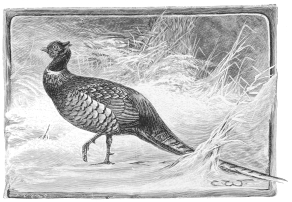 THE OLD COCK PHEASANT
THE OLD COCK PHEASANT
that flew highest should be king. The wren hid itself on the eagle’s
back, and when the eagle had flown its highest, the wren flew up a
little higher still. And “regulus” it remained, even in science, till
quite lately, when some ridiculous fustilarian rechristened it
“troglodytes.” Imagine the wren being “troglodytes,” the same,
scientifically, as the gorilla! What a poverty it betrays in
nomenclature, what a pitiful “superiority to imagination” to find that
the wren and the gorilla are undistinguishable to the eye of a
Professor. “Diabolus” would have been even better, for science has got
no devil now, so the English wren could never have been mistaken for the
great{86} man-ape, and besides, in our folk-lore the wren is a very
necromantic and wicked little person. The Evil One, it is said, once
took possession of its body to serve his evil ends, and infamous
enchanters have done the same. So it came to pass that people said it
was a good deed and pious to kill wrens, and it is hunted to this day in
many places:
“The wren, the wren, the king of the birds,
St. Stephen’s day was caught i’ the furze,
Sing holly, sing ivy, sing ivy, sing holly,
Sing heigh! sing ho! to scare melancholy.”
This is the wren, troglodytes, in its “demoniacal aspect,” to use the
language of Gubernatis. In its benign aspect, “the tiny woodland dwarf,”
“the wren with little quill,” is a bird of some sanctity:
“Malisons, malisons mair than ten
Wha harries the queen of heaven’s hen.”
for, as everybody knows:
“The robin and the wren
Are God Almighty’s cock and hen.”
And it is in its connection with that other famous bird of December, the
robin-redbreast, that the wren, “Jenny Wren,” is, perhaps, most popular.
Indeed, it is almost impossible to think of one without the{87}

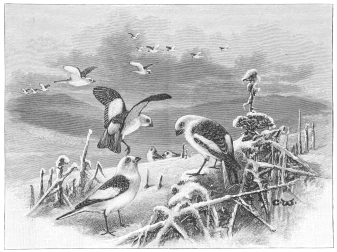 “Like snow-birds that are happy without sun”
“Like snow-birds that are happy without sun”
{88}
{89}
other, for they have been sweethearts ever since English was spoken:
“‘Ah! Robin,
Joly Robin!
Tell me how thy leman doeth,
And thou shalt knowe of myn.’
‘My lady is unkinde, perdé.’
‘Alacke why is she so?’
‘She loveth another better than me,
And yet she will say no.’”
What an enchanting entanglement it is, this of the robin and the wren,
and yet we know that it was approved, for when Cock Robin died, all the
birds in the air, in sympathy for the dead and for Jenny—
“Fell a sighin’ and sobbin’.”
{90}
{91}
CHAPTER III
The Rook—The Cuckoo—Lark and Woodlark—The Sparrow—Plague of Birds
{92}
{93}
CHAPTER III
“The flocking Rooks, by instinct’s native rule,
Each peaceful scene for their asylum choose.”
Shenstone.
ONCE upon a time rooks were called crows, and as the latter had a very
evil reputation, the former suffered for it. Nor is the confusion still
extinct, for unfortunately there are obstinate people in the world who
will not understand that it makes any difference whether they use a
right name or a wrong one. It will be very long before the water-vole
ceases to be called a water-rat; but until that time comes, an innocent
animal will continue to be persecuted for a guilty one. So with the
honest rooks. There are plenty of people who insist on calling them
crows, and having given the bird a bad name proceed to hang him up as a
“scare-crow” to warn his useful relatives off the field which they would
otherwise rid of wire-worms and grubs.
That rooks do some mischief is beyond doubt. When the ground is
frost-bound, and it cannot persecute the farmer’s{94}

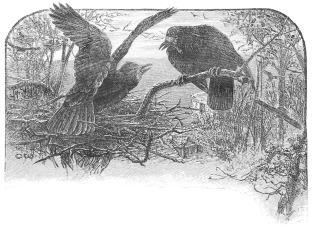 CROWS AT SUNDOWN
CROWS AT SUNDOWN
enemies that hide in the soil, the rook will feed on turnips. When the
potatoes are coming on, the rooks go down between the hills prodding in
the earth for the worms and larvæ that assemble to eat the young tubers,
and, it may be, eating many of them themselves. When hens’ eggs are left
undefended the rook will carry them off. But how very trifling such
damage is as compared with the good that is done by this hard-working
bird. I have myself allowed an acre of potatoes to swarm day after day
with rooks, and when the crop was gathered it was a first-rate one.{95}
After that one experience, and the absolute proof of the innocence of
those rooks when in my potato-field, I need hardly say that when any
farmer complains, or scientist asserts, that these birds do injury to
potatoes when growing, I know he is saying “the thing that is not.” I
have also had eggs stolen by rooks from a nest that a vagabond fowl had
made for herself in the tall meadow-grass. But was the rook to blame?
Certainly not. What right has a hen to go and lay her eggs in a meadow,
carefully hiding them from her friends in the tall grass, but leaving
them conspicuously exposed to every bird that flies over them? As for
its depredation on turnips, what difference in the amount of sheep-food
do the rooks’ pilferings make in a twenty-acre crop? Instead of
grumbling, the intelligent farmer should scatter a barrow-load or two of
mangolds conspicuously over the field for the frozen-out birds to eat at
their comfort and to keep them from pecking the crops.
Indeed, there is scarcely any other bird that has more claims upon the
agriculturist’s goodwill. From sunrise to sunset rooks are always at
work, following the farmer’s men wherever they are disturbing the
ground, and exterminating insects that are thus exposed. At other times
they are patrolling the meadows, going over every foot of ground with
extraordinary patience, and we may be sure that nothing that moves
escapes their keen inquisitorial eye. When the nests are filled with
young ones, the destruction{96} of insect life must be prodigious, for
rooks are large birds, and the voracity of the nestlings is enormous.
But so long as people will call them crows, and as the immemorial infamy
of that name clings to it, so long will the unfortunate birds be
persecuted.
Yet in downright industry the farmer has few such friends, or the
insect-world such foes. Up in the morning, before the dew is off the
grass, before the lark is in the sky, the rooks are hard at work,
disposing of the “first worm” and of the winded things of sunshine,
which, clogged with moisture, are unable to rise from the ground. As
soon as the men are afield, the rooks go to them, following them up and
down with unwearying diligence, and tracking the plough, the harrow, and
the spade, with the fierce unsparing scrutiny of inquisitors. There is
no appeal from them. They hold their court upon the spot, and the
summary procedure of their penal code is the same for all malefactors
alike.
In another respect, this hard-living bird is deserving of regard, for it
prefers the vicinity of human dwellings, and likes to live as near man
as possible. Next to a heronry the existence of a rookery is always
considered to add a charm to an estate, and not without reason, for,
besides investing the place with a fine air of undisturbed ancestral
repose, there is something very pleasant and soothing in the clamour of
rooks in the peopled elms. To those who care to watch them, the burghers
of these “airy cities” are a very{97} entertaining folk. All through the
winter, individuals, or small parties visit their nests, just as if they
came to inspect and report upon the condition of “their wicker eyries,”
and in February these visits become very frequent, the earlier birds
pilfering from other nests to add to and strengthen their own. By-and-by
the whole community begins to assemble, and the rookery is in most
amusing uproar all day, for, for some extraordinary reason, they will
not leave each other’s nests alone, but for the sake of one paltry twig,
will lay themselves open to retaliations, which result in the entire
wrecking of their nests by outraged neighbours, who, though they are so
noisily indignant at the thefts of others, are themselves each in turn
soon after caught stealing and punished.
And yet somehow or another the nests, in spite of ruinous altercations,
manage to get finished, and as soon as eggs are laid, the republic is as
orderly as could be expected. But even then, no nest is left undefended.
In due course the young rooks are hatched, and the truly terrible task
of feeding five mouths is imposed upon the parents. But by constant
industry they fulfil their duties, and by the end of April, or early in
May, the nestlings scramble off their nests on to the boughs, and by
feeble flutterings from point to point, keeping close to their nest all
the time, practise and strengthen their wings. Their first flight to the
ground is a sight to watch, for the{98} youngsters are very nervous, and
the old bird’s patience is sometimes so sorely tried that, having coaxed
them to fly in vain, she pushes them off the branch at last. Once on the
ground they soon learn what to eat, and how to find it; but the instinct
to go to the parents for food is so absurdly persistent, that you may
often see a rook that looks as big as its mother, hurriedly gobbling up
its own worm, in order to go and ask its mother for hers. And the
gravity with which the old bird swallows the worm herself, and then
turns to the overgrown young one, with a “Don’t you wish you may get it,
my dear?” is delightful. So tenacious are these birds of their old
haunts that they are still to be found building in the central postal
district of London, although the steady growth of the city makes the
distances they have to fly for food longer and longer every year, while
the perils they have to encounter on the way, telegraph and telephone
wires, are annually accumulating. But there they are, in spite of
growing London, and are the very first to bring the news to the city
that spring is coming in the country.{99}
“From the neighbouring vale
The Cuckoo, straggling up the hill-tops
Shouteth faint tidings of some gladder place.”
Wordsworth.
Long after the rook, the thrush, and blackbird have told us of the
change of season, “the vernal cuckoo” comes shouting “the same song to
sing.” There is no parable in Nature so hard to interpret as this bird
which the ancients, themselves puzzled, placed on the sceptre of Juno
and the shoulder of Venus. The poet who hesitated to call it a bird—
“Shall I call thee bird,
Or but a wandering voice?
No bird, but an invisible thing,
A voice, a mystery,”—
was not in doubt without reason. For it is, indeed, a mystery. Without a
single “domestic” instinct, dividing its affections among all the mates
it meets, making no nest, caring for no young, leaving the country as it
came, without kith and kin, it is a bird to wonder at and to puzzle
over. How comes it that it lays so small an egg, and so coloured that it
can leave it in little birds’ nests without exciting their suspicion?
and what law in Nature makes the small foster-parents so idolise{100}

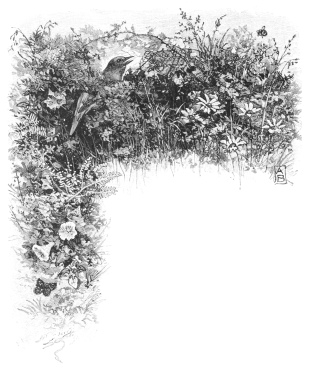 “In some brake of fern and bramble”
“In some brake of fern and bramble”
the little assassin who murders their young that they abandon their own
nestlings to their fate without, apparently, any compunction, and
concentrate their affection and their pride upon the solitary monster
that is left, the destroyer of the rest? And even when the thing has
grown so big that its open mouth is almost large enough to engulf its
foster-parents, they go on feeding it and following it about as if
fascinated by the wretch. Those who wish us to find “sermons in stones,
and good in everything,” must surely{101} hesitate when they come to look
for a moral in the joyous life of the “plain-song cuckoo gray.” That it
eats hairy caterpillars which no other bird dares to swallow for fear of
choking, is certainly a point in its favour, and its ever-welcome
“spring-delighting” voice is another. But neither its song, “its two old
notes,” nor its consumption of “woolly bears,” gives human reason a
sufficient explanation of its unique iniquity, or justifies its gay
enjoyment of a life of perpetual summer without any responsibilities.
The Psalmist, seeing “the wicked flourish,” broke out into bitter song;
so might the poor hedge-sparrow and the pipit.
With the cuckoo come many birds from abroad, and all of them welcome,
for they fill our gardens and woodlands with varied song, and wage
unremitting war upon our insect pests.
There are not, probably, many people who notice either their coming or
their going, for spring and winter are supposed to be sufficient
explanation in themselves for the commencement and cessation of song.
Even those who have gardens do not always notice the little
singing-birds from abroad, for their plumage is very modest in colour,
their habits are shy and retiring, and their songs always sung from the
cover of some brake of fern or bramble, some sequestered corner where
only the vagabond butterfly catches sight of them as it goes flickering
to and fro in its quest of flowers.
Both garden-warbler and blackcap are more often heard{102} than seen, and
their song, by those who have never heard the nightingale, is regularly
mistaken for that bird’s. Indeed, when two blackcaps are singing against
each other, the alternating songs seem continuous, and the strength of
the voice and the extreme beauty of their notes arrest the ear at once,
while, being so unlike the song of either blackbird or thrush, which are
heard as a rule only from tops of trees, the music is at once called the
nightingale’s. Or how many of us notice the woodlark (a bird that stays
with us all the winter through), even though its song is finer than the
skylark’s?
“A woodlark, o’er the kind contending throng
Superior heard, ran thro’ the sweetest length of song.”
On the wing, no doubt, it is mistaken for “the lark,” but when singing,
especially at night, in the shrubbery or copse, as often for the
nightingale; yet it is common enough, and if those who care to do so
will, when they hear its exquisite song, stop and look round for the
singer, they will see, sitting on a branch, a bird just like the
skylark, but will notice, if they listen, that its voice is richer and
its notes more varied than the laverock’s, and that the bird shifts from
one perch to another while it is singing, sometimes even mounting to the
top of a tree, and thence, still in song, flying up into the air to
circle. If you startle a skylark it will never, you will notice, fly to
woodland for shelter, but only to another part of the meadow or into the
next, and settle there on the ground,{103} so that whenever a bird that you
think is a “lark” flies on being startled into a tree, you may be sure
it is the “soft enamoured woodlark”—next to the nightingale the
sweetest minstrel of the copse.
“The woodlark breathes in softer strain the vow,
And love’s sweet burthen floats from bough to bough.”
A skylark, as every one knows, sings, as a rule, when in the air, but
it, too, will sing upon the ground; and in its cage, forgetful
apparently of its captivity, pours out its song with the same enchanting
gaiety as when it is free of all the sky.
“What objects are the fountains
Of thy happy strain?
What fields, or waves, or mountains?
What shapes of sky or plain?
What love of thine own kind? what ignorance of pain?”
As seen in Nature, there can be nothing imagined more exultant, more
heartily joyous, than the glad, eager way in which the skylark seems to
spring up from the meadow and commence its artless canticles of praise
as thanks for its happiness and freedom. Yet, perched upon a scrap of
turf, in a cage so low-roofed that it cannot attempt to rise, it sings
the same “strains of unpremeditated art” that so charmed the great poet,
and live for ever in his deathless verse. Even in winter, on a sunny
day, the lark will soar up into the air{104} “like an embodied joy whose
race is just begun,” and “shower a rain of melody.” For some stay with
us all the year round, though most of their companions go, and in such
vast flocks that fifteen thousand have been caught in a single night out
of a flight passing a single spot. And, poor little birds, wherever they
rest on their journey they find nets spread for them, for every nation
alike is agreed that larks are good to eat; and so they go, to and fro,
literally “larding the earth” with their bodies. Yet in spite of these
periodical massacres, and in spite of perennial persecution for the cage
and the table, their numbers never seem to lessen, and our skies and
meadows are as full of them one year as another. And it is well that it
is so, for what should we miss more in a country walk than “the lark’s
blithe carol from the clouds”?
“Sound of vernal showers
On the twinkling grass,
Rain-awakened flowers,
All that ever was
Joyous and clear and fresh, thy music doth surpass.”
Yet, introduced into New Zealand, they have become a pest, ravaging the
cornfields when the blade first appears above ground, and pulling up,
grain by grain, every plant in the field. The goldfinch, also imported
into the colony, now flies about in wisps of hundreds, inflicting
serious damage on the buds of crops and fruit-trees. It is a severe
lesson this in{105} natural history that we have learned, trying to exchange
the wild creatures of different continents. Australia is in despair over
the rabbit, and the Colonies and America alike hold the sparrow in
abomination.
“The Sparrow, meanest of the feathered race,
His fit companion finds in every place.”
Cowper.
When I was travelling in the United States in 1883, I drew the
sparrow-line from personal observation at Omaha on the east and Salt
Lake City on the west. From the one side it had not then crossed the
Mississippi. But it was steadily advancing, the aggressive little fowl,
from both seaboards, and while it had pushed forward from the Atlantic
into Illinois, so from the Pacific it had then travelled as far as
Nevada. The tyranny of the sparrow is part of the price men pay for
civilisation. Only savages are exempt. In America it has developed into
a multitudinous evil, to which our own grievance against the bird is
nothing; has dispossessed the children of the soil, and thrust its Saxon
assumption of superiority upon the feathered natives of the country.
Sparrows do not respect Congress, and take no notice of legislative
enactments for their extirpation. Imported as an insect-eating treasure,
they have turned out grain-devouring{106} impostors, and presuming upon the
affectionate sentiments of exiled Englishmen have become a veritable
calamity, and practically are officially branded as “vermin.” In New
York and other cities, the townsfolk began by putting up nesting-boxes
for the birds to build in, in the public gardens and on corners of
buildings. But now, if they could, they would introduce a pestilence
among them and exterminate the race. It is the same in Australia, and
the man who “invented” the sparrow stands in the monument of public
infamy only one niche lower than “the man who invented the rabbit.” And
“pity ’tis ’tis so.” For the sparrow is not an unamiable fowl. The poet
who blesses it “twittering forth its morning song, a brief but sweet
domestic melody,” went perhaps too far, for if there is one thing for
which “the nightingale of our roofs” deserves persecution, it is the
exasperating monotony of its soulless chirp, and thus it is that one
feels inclined to echo all Prior’s abuse of it:
“Begone! with flagging wings sit down
On some old penthouse near the town;
In brewers’ stables peck thy grain,
Then wash it down with puddled rain;
And hear thy dirty offspring squall
From bottles on a suburb wall.”
But in spite of its monstrous impudence, or partly, perhaps, because of
it, the sparrow is really a popular favourite. Of course, no one takes
it very seriously. When the cat is seen{107} on the lawn with a bird in its
mouth, there is at first a thrill of indignation and horror, but when
some one says, “It’s only a sparrow,” the indignation is greatly
modified and the horror subsides. For though the cat may not catch a
chaffinch without reprobation, she may fatten on sparrows without
reproach.

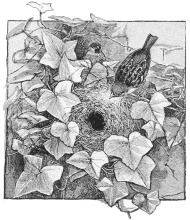 HOUSE SPARROW
HOUSE SPARROW
Trying once to breed poultry, I found that ten sparrows to every fowl
meant double expense in feeding, and as the sparrows were not starving,
but only too lazy to go and find food in the fields, I had no
compunction in “harrying” them, though I would not allow any one on the
place to touch the nest of any other bird whatsoever. Not that sparrows
care for persecution when it takes the form of pulling down their nests,
for they seem to rejoice at the opportunity of beginning housekeeping
all over again, and, as I have proved by experiment, will have started a
new family in a new nest three days after{108} the old nursery has been
destroyed. What they detest is wire-netting of too fine a mesh for them
to get through and the spectacle of grain scattered inside which they
cannot reach. It is then that poor feeble man triumphs over the
obstreperous sparrow and can exult over the birds as they hop, chirping
round and round the impossible feast.
In London there is always enough food for the small creatures, and even
in the hardest winter, when blackbirds and thrushes and all kinds of
other birds, unsuspected residents many of them, are picked up dead in
the parks and gardens, the sparrow is not pinched. So that in the
popularity of the sparrow there is no tenderness involved. Londoners
like him because he is one of themselves, because he is plucky and
self-reliant, taking things much as they come; because he stands upon
his rights, or what he has come to call his rights; is robust, and never
“down at the mouth.” He is a dirty little ragamuffin, but not in the
least ashamed of himself, for he takes his small smoky dusty person into
the presence of Royalty with as much assurance as into a mews, and
chirps as complacently all through service in Westminster Abbey as in a
rain-spout in Shoreditch. The metropolitan cat seldom arrives at a
sparrow, just as the small gamins of the streets never get run over by
cabs. Their whole lives are spent in evasion, and they develop an
extraordinary agility in escaping from accidents. I find it very hard to
defend the familiar little fowl and almost as hard to accuse him. That
he behaves with{109} levity in places of public worship, that he is
disrespectful to bye-laws and perpetually trespassing, is true enough;
but how can you bring such misdemeanours home to a bird who hops up a
water-pipe in reply to your charges? In private life, too, he is
disreputable. As a frivolous parent given to rolling the eggs out of the
nest, and even also his infant progeny; as an unworthy spouse,
transferring his affections lightly, and often assaulting the partner of
his joys and sorrows (and in return as often assaulted by her); as a bad
neighbour, scuffling with his kind whenever he meets them—in each of
these respects he presents himself to the severely moral mind as
undeserving of respect. Yet with something of the eccentricity of
judgment which commends to public regard the truly infamous Punch, who
hangs the hangman, kills his wife, and throws the baby out of the
window, we persist in looking upon the sparrow, with all his notorious
faults, as a popular favourite and resent any serious exposure of his
obliquities.
“Touch not the little sparrow, who doth build
His home so near us. He doth follow us
From spot to spot amidst the turbulent town
And ne’er desert us. To all other birds
The woods suffice, the rivers, the sweet fields,
But he doth herd with man.”
In one aspect he is altogether admirable—as the comrade of Britain’s
soldiers and sailors in times of war. Wherever{110} our ships go the sparrow
goes, and as the troops march he accompanies the army as a
camp-follower, but finding his own rations. He is established in
Afghanistan, where he went with Roberts and Stewart, and in Zululand
where Evelyn Wood and Buller showed him the way. Like the Roman eagles,
he is the ensign of victorious advance, and should I ever chance to go
there, I expect to find him at home, by right of arms and the men, at
Buluwayo. As they crossed the Cabul river and the Buffalo and the Nile
with our forces, claiming at once from the natives privileges of
conquest which our generals hesitated to assert, so no doubt they have
crossed the Shangani, and among the rock-kranzes and kraals of the
Matabele now rear the young which, under other conditions, might have
lived in Covent Garden and died within sound of Bow-bells.{111}
CHAPTER IV
Bird-Voices—The Corn-crake—The Black-Tap—the
Turtle-Dove—Carpenter-Birds—The Nuthatch—The Wryneck—The Great
Tit—The Letter-box Tit of Rowfant
{112}
{113}
CHAPTER IV
“Clam’ring Craiks at close of day
’Mang fields o’ flowering clover gay.”
Burns.
WHICH bird-voice in Nature is the most expressive? Is it the ringdove’s
happy crooning in the green depths of the woodland? or the nightingale’s
solitary lamenting under the cold moon? Some might say the fierce,
ringing cry of the Highlanders’ eagle among the clouds; others the
soothing, homely clamour of the social rooks in the old Hampshire elms.
Or is it some other? For myself, I think I would pass them all by,
significant utterances though they are, like the cuckoo’s tell-tale
note, the sparrow’s familiar chirp, the glad carol of the skylark, the
placid vespers of the blackbird, and the joyous matins of the thrush;
pass all these by, and many others, and choose—the cry of the
corn-crake. Have you ever noticed that while you listen to the cuckoo
calling, other birds seem to be silent? The cuckoo, for the time, is the
only voice in the sky. So it is with the corn-crake. When{114} you hear it,
it is all alone. A short while ago the whitethroat was pouring out its
little heart in an evening-song, and from the copse came the chuckle of
the roosting pheasant. A night-jar had been purring over the golden
furze that grows up from among the purple heather, and on the other side
of the spinney an owl, on soft white lazy wing, had gone by crying to
its mate. Queer little noises, “flung out of their holes” by rabbits,
and others just as queer, but more inexplicable, from hedgerow and
ditch, had told you that animal-life was on foot and a-wing, and as you
sate on the stile, in the break of the high hedge, and saw the steam
rising out of the clover, and the white moths, “ermine” and “ghost,”
flash or flutter among the sweet bloom, it seemed as if everything was
abroad, the day-things not yet asleep, the night-things already astir.
And all of a sudden the solitary corn-crake cries from the wheat. At
once the whole air seems to hush: the very evening to listen.
Crake-crake comes the cry, and there gathers over the scene an
indescribable atmosphere of completest tranquillity. Crake-crake. Far
away, somewhere in the dip beyond the rise, sounds a sheep-bell, and the
chiding voice of the shepherd’s dog. But there is not a sound besides.
Crake-crake. And the mist creeps up the corn-stalks, and covers the
campions, and the air grows damp with dew. It is going to be another hot
day to-morrow, just as it has been to-day. Crake-crake, cries the
creeping rail, and{115}

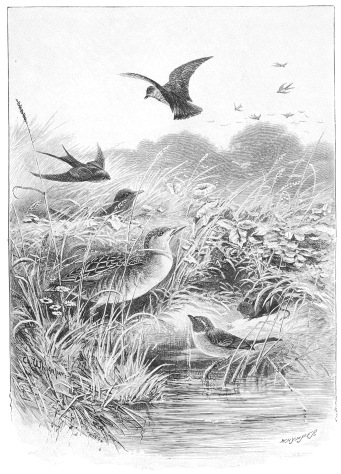 THE CORN-CRAKE AND ITS COMPANIONS
THE CORN-CRAKE AND ITS COMPANIONS
{116}
{117}
never a voice replies. And so homewards, up through the meadow,
hummocked with hay-cocks, and rough to the feet with short
grass-stubble, from which the sleepy skylarks spring at every step: up
to the elms that shade the garden, and on to the lawn. The bats wheel
overhead, their soft wings crumpling as they turn their somersaults, but
never a voice in the air, save sharp needle-points of sound, as
flittermouse calls to flittermouse. Only from among the wheat, now here,
now there, comes up the cry of the rail, Crake-crake.
It is a charming bird, sufficiently rare to make the seeing of it an
event to remember all the summer; the finding of its nest a triumph. And
then to see the young ones!—little black imps that run like spiders.
Once only in my life could I have shot one. I was out with my gun,
“strolling round” for the unconsidering evening rabbit, when all of a
sudden from under my feet, in the furrow that separated the turnips from
a patch of lucerne, up got a bird, and its slow, clumsy flight told me
that it was a corn-crake, and for the sake of its little black imps I
lowered my gun and let the poor mother go.
But the corn-crake has done crying, or has wandered away into another
field beyond hearing, and here in the garden the voices of Nature soon
reassert themselves, and, resonant above the rest, the blackcap is
singing
“musical and loud,
Buried among the twinkling leaves.”
{118}
Whence comes this little musician? It may be from Persia or Abyssinia,
or perhaps it has only stepped across, so to speak, from Norway. But
here it is with its nest among the ivy and periwinkles on the bank, and
its beautiful eggs, delicious little mottled ovals of jasper, complete
in number in their cobweb cup. It is odd how few people, even those who
are “fond of birds,” and have large gardens and grounds, know this
little visitor by sight, or even by song. And yet it needs only a few
minutes’ patience when once the blackcap is seen to watch it to its
nest, and that once done it can be examined, as I have examined it, with
a magnifying-glass at the end of a walking-stick, while it sits upon its
eggs. Few birds are really more trustful in the places they may choose
for their nests, or more courageous in remaining upon them when
approached, than this pretty bird with the lovely voice.
“Deep mourns the Turtle in sequestered bower.”
Beattie.
“The Ringdove in the embowering ivy, yet
Keeps up her love lament.”
Shelley.
Another bird seldom seen, or when seen recognised, is the turtle-dove.
Its purring in the thicket is mistaken for the wood-pigeon’s by ears
that are not on their guard for{119} differences of note, and yet, if once
recognised apart, the two can no more be confused than the rook’s and
jackdaw’s. Of all birds I think it one of the stealthiest. Though
building its nest where discovery seems almost certain for so large a
fowl, it does its work with such secrecy that I doubt if any one in
England ever saw a turtle-dove with a twig in its beak, or tracked it to
its nest by its flight. I have found dozens of turtle-doves’ nests, but
never one betrayed by the old birds. Yet the grasshopper warbler,
supposed by most people to be one of the most subtle of nest-builders,
and by its tiny size, its mouse-like habits, and its concealing colour,
so carefully equipped by Nature for security, can be watched home to its
nest, as I know from my own schoolboy days, with unerring certainty. It
betrays itself in every action. You have only to “locate” the small
ventriloquist’s cricket-voice and then lie down among the herbage and
wait. From impatience the little birds are sure to show themselves, and
if they are building they hop up and down, twist in and out of the
lowest plants, with material for their nest in their beaks, and you have
only to lie still and watch.
But “watching” all day long will do no good with turtle-doves. Whether
building or not, they never tell you, and when they catch sight of you
they fly off at once, as if they did not care where they flew to, or
whether they ever came back there again. Let them go, but come back
yourself later on to the same spot, approaching it, however, from the{120}
opposite direction. And if you flush them again, you may be sure that
their nest will be, or is, thereabouts: midway, probably, between the
two points of your approach. In a few days go back to find the nest, and
if you walk backwards and forwards in the undergrowth, keeping your eyes
upwards, so as to look through the bushes from underneath, you will find
it, if it is there. For the hen-bird sits very close, and goes off her
nest with a flap of the wings that is unmistakeable. Apart from this, if
the bird is not at home, you may often find the nest by seeing the white
eggs in it from underneath, the yolks of them showing against the sky a
delicious pinky yellow. For the nest is a mere ghost of a nest—a
skeleton—and can easily be imitated by taking a handful of thin birch
and hazel twigs and sprinkling them at all angles in a heap. Such a nest
a pair of birds may easily build in half an hour, and this, perhaps, is
one reason why they are never seen at work. Why they should be content
with such a skeleton of a nest or how so frail a network bears two bulky
nestlings and their mother, is a mystery. But as Prior sings:
“Each according to her kind
Proper material for her nest can find,
And build a frame which deepest thought in man
Would or amend or imitate in vain.”
When they are on the wing, turtle-doves seem to like to keep below the
level of the tree tops, and seldom, therefore,{121}

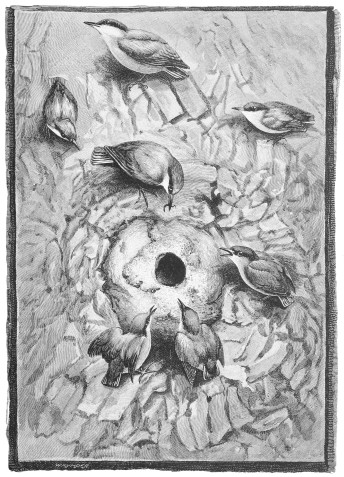 THE NUTHATCH AT HOME
THE NUTHATCH AT HOME
{122}
{123}
come into sight conspicuously. But I have sate in an orchard and watched
them, several together, flying about among the apple-trees, and feeding
on the ground, when they were unconscious of my presence. Their flight
is singularly beautiful and interesting, for the obstructions they meet
with compel them to make the most graceful and sudden evolutions to
avoid collision.
And I remember very well, how, as I sate there, looking up from my work
every now and again at the wing-clapping and testily-cooing strangers,
sporting and squabbling by turns, I heard, what I had never heard in
that garden before—the tapping of a nuthatch.
“Nuthatch piercing with strong bill.”
Southey.
“Rap-rap, rap-rap, I hear thy knocking bill.”
Montgomery.
Tracing up the small smith, I found it busy on the trunk of an old
Scotch fir, where it found, if not ants, a colony of some other small
insects, for it was picking them off right and left as they fled along
the bark. This bird has discovered that if it raps upon a bough, the
insects in the crevices are startled from their hiding-places by the
jarring,{124} and rush out, like human beings after an earthquake shock,
into the open air, where the nuthatch soon disposes of them; and, unless
I am mistaken, it is the only British bird that arrives at its food by a
deliberate guile. All others, I think, catch their food by chancing to
find it abroad, but the nuthatch accomplishes the effect by a reasonable
cause, and frightens out of their chinks the creatures that it wishes to
capture. Sometimes the insects only scuttle from one refuge into
another, but the nuthatch rips the bark off in flakes and pursues the
poor wretches from covert to covert.
It takes its name from another peculiarity, its fondness for nuts,
beech-mast and acorns, which it fixes tight into some little crevice in
the bark and hammers open. Looking at the shells of hazel-nuts that it
has cracked, I believe that it first pecks a hole, and then getting its
beak into it crosswise to the natural cleavage of the shell, splits the
nut with a sharp rap on the bark. Its beak enters like a wedge and,
while the two half-shells drop to the ground, one on either side,
pierces and holds the kernel. It must take it out of its vice to split
it, for while tightly gripped the bird could only pierce a hole in the
nut and not cleave it, and this is evident if we put the two halves
together, for we then see that though a hole was made, the shell did not
split. The bird had to take it out of the cleft on its beak and knock it
on the tree.
When nesting, it is not content with a hole that just suits it in size,
but must needs choose a large hole and then{125} plaster it up with mud till
it becomes small enough. With the rest of the animal world the rule is
to select what fits them at first, and failing this to enlarge the house
to their needs. But the nuthatch has sense on its side, for it is easier
to reduce than to increase, and which of us, if the sizes of houses made
no difference in their rents, would not occupy by preference tenements
with what auctioneers call “commanding approaches,” and “noble entrance
halls,” even if we only used the back-door to come in and go out at? So
the nuthatch picks out a big hole and then reduces it to its own
dimensions, and the little nuthatches no doubt, when the tree-creepers
happen to come by, speak boastfully of “the woodpecker’s house” that
they live in, but never say that they keep the great front-doors shut
and get in and out by the scullery-window.
Another little hole-nesting bird, an alien not often seen, is “the
cuckoo’s mate,” the wryneck, a bird of very pretty plumage, mottled and
barred, and yet curiously inconspicuous when clinging to a tree-trunk.
Should you chance upon its nest it will twist its neck about in an
extraordinary snake-like way and hiss, a procedure which in other
countries may sometimes, perhaps, protect the small creature from
capture, but in England, where tree-snakes are not common objects of the
country, can hardly do the wryneck any good. At other times, too, it
will pretend to be dead when you take it up, as the corn-crake will, but
as soon as it sees a chance of escape it is off.{126}

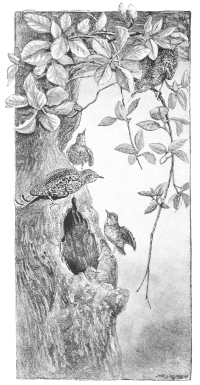 NESTING-HOLE OF WRYNECK
NESTING-HOLE OF WRYNECK
But when a bird is heard tapping in garden or orchard, it must not be
taken for granted that the workman is either a nuthatch or a wryneck,
for the “great tit,” the “oxeye” of many country places, has the same
habit of fixing nuts or seeds in crevices and hammering at them with its
bill till they split, and it will also search the bark of trees with its
beak in quest of insects. But above all the birds of our English
gardens, not excepting the sparrow (which, though an insolent is not a
fearless bird) and the robin, the great tit confides in man and in all
his doings.{127}
I wrote once in a magazine an account of how I had caught the same great
tit nine times in one afternoon, had nine times put it into an aviary,
and nine times had found, on going to look for it, that it was gone. And
a newspaper critic of my article suggested that I had been mistaken or
something worse.
But a year later I found that I had Dr. Günther with me; for in an
article written by him, now before me, he says that he has caught the
same great tit over and over again, and that at last the bird,
discovering that nothing disagreeable resulted, coolly went on eating
while the trap snapped over him. My own experience was in the hard
winter of 1892. I had put out a long row of traps, and visitors were
very numerous. Among them came a great tit which was caught and put into
the aviary, and to cut the story short, nine times a great tit was
caught and nine times put into the aviary. But when in the afternoon we
went to look at the captives, there was not a great tit among them all.
Then the thought flashed upon me that we had been catching the same bird
over and over again. Then we caught another great tit, and this time,
before letting it go, we marked its tail, and sure enough the next great
tit we caught had its tail marked. So instead of putting it into the
aviary we fixed the trap open to let it eat its fill of chopped fat and
hemp-seed without molestation.
How did it manage to get out? The mesh of the{128} netting over the aviary
was small enough to keep siskins inside, but the great tit, as we
afterwards found, was not to be kept within the wires. It turns its body
sideways, puts a wing through first and then its head and then squeezes
the body out—exactly the same procedure, that is, reading arm instead
of wing, as the professional child-burglar’s in India. If the great tit
cannot get out of its prison, it commits suicide. For it thrusts itself
so far through the wires or netting that it cannot move one way or the
other, and is strangled.
Dr. Günther elsewhere gives an instance of fearlessness which is no
doubt paralleled in animal history, but certainly never excelled, and
for once I must break my rule and make a quotation in honour of the bird
of Rowfant. So many vaguely authenticated stories are current that one,
on such authority, is very valuable. “In the year 1888 a pair of great
tits began to build in a post-box which stood in the road in the village
of Rowfant, Sussex, and into which letters, etc. were posted and taken
out of the door daily. One of the birds was killed by a boy, and the
nest was not finished. However in the succeeding year, it appears, the
survivor found another mate, and the pair completed the nest, filling
nearly one half the box with moss and other nesting materials. Seven
eggs were laid and incubated, but one day when an unusual number of
post-cards were dropped into and nearly filled the box, the birds
deserted the nest, which was afterwards removed with the eggs and
preserved. In 1890 the pair built a new nest of{129} about the same size as
the previous one, laid again seven eggs, and reared a brood of five
young, although the letters posted were often found lying on the back of
the sitting bird, which never left the nest when the door was opened to
take out the letters. The birds went in and out by the slit for the
letters on the side of the box.”

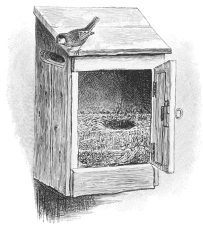 THE TIT OF ROWFANT
THE TIT OF ROWFANT
Could anything be more charming, more touching, than this? and does any
bird that breathes English air deserve more respect for its delightful
confidence in man, more assistance in its times of stress and want, than
the great tit? But it is not a bird that many people think of when they
try to remember the lovable creatures that haunt their garden. For one
thing, it is so restless that it seldom remains in sight more than an
instant, and, as often as not, its crisp bright call is the only sign
that we have of its presence as it{130} flits to and fro after insects among
the tree-tops, dropping suddenly on to the ground after a falling
caterpillar, and as suddenly skipping up branch by branch to the height
it had left. Whenever heard, even in the depth of winter, it is cheery,
crying out with just as brisk and hearty a voice as when the summer sun
was shining.{131}
CHAPTER V
The Owl—The Magpie—The Kestrel or Windhover—Haunts of the
Heron—Bird-Destroyers, the Gamekeeper and “naturalist”
{132}
{133}
CHAPTER V
“Sad Aziola![A] many an eventide
Thy music I had heard
By wood and stream, meadow and mountain side,
And fields and marshes wide,—
Such as nor voice, nor lute, nor wind, nor bird
The soul ever stirred:
Unlike and far sweeter than them all.
Sad Aziola from that moment I
Loved thee and thy sad cry.”
Shelley.
ANOTHER bird that visits country-houses with unbounded confidence in
man, if man would only recognise it, is the owl. How many people know
that if they will put little barrels up in trees, or among ivy, that the
barn-owls will accept the invitation and make the barrels their home,
bringing to it many a hundred mice in the course of the year, and
scaring away thousands more? Yet such is the case. And those who keep
pigeons need not be alarmed. The owl will not touch{134} them, and the
owners, if they will take the trouble to watch, may see the owls making
the dove-cot their perch and their starting-point on their sallies,
their tower of observation, and the pigeons showing no uneasiness
whatever at the coming and going of the cat on wings. When will the time
come that gamekeepers, under pain of immediate dismissal, will be
forbidden by their masters to shoot owls? As it is, this bird, which
ought to be as common as the rook, is actually rare; and when it goes
out to kill the mice and rats, which are the farmer’s worst enemies, it
has to sneak to and fro as if it was a criminal, doing something that it
should not—
“a furtive owl on stealthy wing.”
Owls, as a matter of fact, should be tempted in every way to live
amongst us, and a reward should be given to every farm-hand who brought
first news of a nest upon the grounds. That they do no mischief is
absolutely beyond all doubt; that they do an enormous amount of good is
as absolutely on proof. Yet farmers’ gamekeepers, many of whom are
simply poachers promoted to private employment, grossly ignorant and
brutal men, are allowed to shoot these valuable birds as if they were a
pest. Poor owls! They had a bad name given them in the beginning, and,
such is the persistence of popular prejudice and superstition, their bad
name still clings to them among the class of rustic from which the
farmers’ gamekeepers are too often selected, the men who{135} commit the
very offences of egg-and-game stealing, of which they falsely accuse the
owl.
The literary history of this admirably useful and beautiful bird is a
chronicle of calumny and ill-treatment. There is no epithet too bad for
it in poetry; it is deadly, dreadful, wicked, hateful, fearful, fatal,
dire, accursed, curst, unhallowed, obscene, and is called every kind of
name, “bird of hate,” “of the grave,” “of death,” “of gloom,” “messenger
of death,” “herald of disaster,” “foul bird of omen.” “The screech-owle
betokeneth always some heavy news, and is most execrable and accursed in
the presages of public affairs. He keepeth ever in the deserts, and
loveth not only such unpeopled places, but also that are horribly hard
of access. In short, he is the very monster of the night, neither crying
nor singing out clear, but uttering a certain heavy groan of doleful
moaning. And, therefore, if he be seen within cities, or otherwise in
any place, it is not for good, but prognosticates some fearful
misfortunes.” These are Pliny’s words, and sum up therefore the
collective opinion of antiquity. Nor has this opinion ever changed, for
poets in our own century sing of—
“Birds of omen, dark and foul,
Night crow, raven, bat, and owl.”
Little by little, no doubt, the superstition will die out; but they die
so hard, these prejudices of the ignorant, that the{136} owl runs a risk of
becoming extinct before it is properly appreciated.
“An impudent presuming Pic,
Malicious, ignorant, and sly.”
Cunningham.
“So have I seen, in black and white
A prating thing, a Magpie hight
Majestically stalk;
A stately, worthless animal
That plies the tongue and wags the tail,
All flutter, pride and talk.”
Pope.
Another handsome bird on “the tables of proscription,” is the magpie;
but it deserves all the persecution it receives, for though it certainly
eats a certain number of snails and insects, it is far more partial to
eggs and young birds; and its audacity is so extraordinary, that only
its death puts an end to its marauding, while its cunning is such that
shooting a magpie is a matter of the greatest difficulty. The numbers
that are destroyed annually must be very large; but the magpie is a
prolific bird, and withal so astute in its nest-building that it is
still in the greater part of the country a common object. Its nest,
indeed, is a fortress, proof against all natural enemies, and offering
even considerable chances of{137}

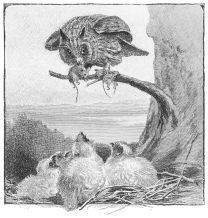 LONG-EARED OWL
LONG-EARED OWL
immunity from man, for it barricades it with thorns, domes it over, and
very skilfully conceals the entrance. Moreover, it has the sagacity to
build, as a rule, in tall hawthorns, than which no tree offers more
difficulties to even the hardiest and most weasel-bodied bird’s-nester.
Failing trees, as happened in a certain barrens pot in the north of
Scotland, magpies will build in a gooseberry-bush, but finding this
position exceptionally exposed to enemies, they not only built their
nest of the usual strength, but fortified the bush itself with a
chevaux-de-frise of dead gooseberry-twigs, a foot in thickness, and
impenetrable even by a mouse. To this stronghold{138} they returned year
after year; but the cottagers, who gave the birds protection for the
sake of their society, were compelled to confess that the only return
the pies made for their clemency was to try to rob the hens and kill the
chickens.
Jays in many ways resemble magpies, being quite as cunning and just as
destructive; and even those who are most averse to the persecution of
any wild creature are compelled to warn the jay off their premises if
they wish their game to thrive, or the song-birds in their shrubberies
to live in security. For this beautiful but unprincipled bird is a most
diligent and successful bird’s-nester; and, in spite of its conspicuous
plumage, so stealthy in its mischief, that a pair will “work” a
shrubbery thoroughly without betraying themselves even to the gardeners.
Even if the clamour of the small birds attracts you to the spot, you
will see nothing to explain their alarm, and the cat that you afterwards
come upon watching for a mouse under the bushes is saddled with the
blame which ought really to be fastened upon the pretty wretches that
are watching you from the foliage overhead. The magpie and jay are, I
confess, two birds that I like to see—on other people’s grounds. On my
own I should prefer them stuffed, and right handsomely do they lend
themselves to the artistic taxidermist. In combination and contrast no
two birds are more beautiful, and as an ornament for a hall or
billiard-room are not to be surpassed.{139} For to the maximum of admiration
there goes only the minimum of compunction.

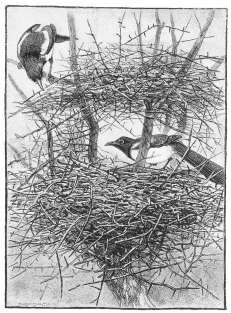 THE MAGPIES’ FORTRESS
THE MAGPIES’ FORTRESS
But this is not the case with another of the brutal gamekeeper’s
victims, that exquisite little falcon, the kestrel. All day long it is
busy at the good work which the owl{140} takes up at nightfall, for it lives
almost entirely upon mice, and, these failing, upon large insects,
especially the destructive cockchafer. It so very rarely molests a bird
that, hawk though it is, you never see the smaller feathered-folk in
alarm at its approach. “He is no enemy of theirs, and mingles freely
with them, almost unheeded.” Observe what consternation the sparrow-hawk
brings to the little songsters when he is abroad; but how different when
the kestrel passes overhead! The chaffinch, instead of uttering cries of
alarm, continues his merry notes; and the larks and pipits pay no
attention to the little bird of prey. When it hovers over the farmyard,
or hunts round the ricks, no anxious hen clucks to her scattered family
any note of warning or recall, the sparrows continue at their meal, and
the swallows, unconcerned and trustful, wheel twittering in the air. Its
nest is sometimes found in holes in buildings where doves and starlings
are its companions. But for mice of all kinds the kestrel has only
unrelenting and ceaseless hostility; and it has been calculated that a
single pair will account in a season for the astonishing number of ten
thousand.
Its favourite method of hunting makes the kestrel a familiar bird by
sight, and gives it its name of “windhover,” for,
“as if let down from the heaven there
By viewless silken thread,”
it hangs suspended in the air over a given spot, until it either{141}

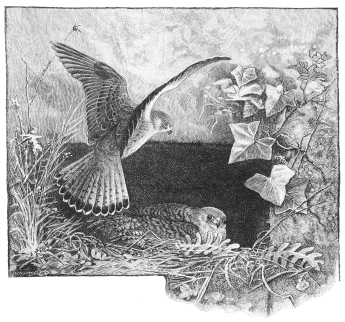 WHERE THE KESTRELS BUILD
WHERE THE KESTRELS BUILD
{142}
{143}
sees a mouse below it, upon which it then drops with lightning speed, or
else decides that there is nothing there, when it moves on a little
further and hovers again, thus beating a field or moor thoroughly over
before it leaves it. And while it is thus engaged the gamekeeper steals
upon it and shoots it, and, taking it home, the mutton-headed ignoramus
that he is, nails it up on his “tree,” in the company of that other good
friend of man, the owl.
“Long-necked Heron, dread of nimble eels.”
Leyden.
“Unhappy bird! our fathers’ prime delight,
Who fenced thine eyry round with sacred laws,
Nor mighty princes now disdain to wear
Thy waving crest, the mark of high command.”
Somerville.
But the gamekeeper’s enormities reach their climax when he murders that
noble bird the heron. His master perhaps has a field or two that runs
down to a stream, and in the advertisement, by which the thrifty farmer
makes annually a few pounds, of “so many acres of shooting to let,”
there is added, the “right of fishing in the river so-and-so.” So if by
any chance a poor heron, strayed from the upper reaches where some
nobleman or gentleman preserves this fine bird, comes on the farmer’s{144}
meadows, the farmer’s gamekeeper (it is sport exactly to his taste)
stalks it from behind the line of willows and kills it as it stands
there. He will probably get a shilling for it from the birdstuffer, and
that is quite enough reason to him for destroying the heron. It is a
great pity these miserable men are allowed to fire anything but blank
cartridge. On the larger estates the head-gamekeeper is often a man of
intelligence and a sound naturalist, and owls and kestrels are not
murdered, and the heron, of course, goes free. But on either side of him
may be a farmer who keeps a “gamekeeper” who steals eggs and young birds
from his aristocratic neighbours, so that his master may let his
“shooting” to some “city gents from London,” and who, though there maybe
a heronry on the adjoining estate, kills the birds when he gets the
chance, because, as he says, he has to “preserve the fishing,” but
really because he can get a few pence for its skin. Sometimes a heron
appears in a poulterer’s shop and finds a purchaser who is curious in
matters of eating[B] and wishes to taste a fowl that once was so highly
prized as to be the dish of honour in the game course at banquets of
State.
But there are not, I fancy, many men, except farmers’ “gamekeepers” and
their confederates the so-called “naturalists”,{145}

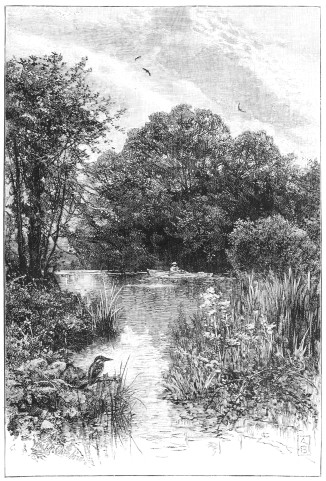 “Enhancing every charm by its transient brilliance”
“Enhancing every charm by its transient brilliance”
{146}
{147}
who would pull a trigger upon a heron. The admiration of Nature is very
sincere in the educated Englishmen of to-day, and by far the greater
number of them would rather see the beautiful creature making their
estate its home than kill it. It is, indeed, the very genius of
beautiful solitude, and by its mere presence raises the commonplace to
the picturesque.
Take a secluded bend of any stream, with its alders and willows, its
wild flowers stealing down to the water’s edge to see their faces in the
glass, and yellow flags boldly wading out by their companies and
battalions into mid-stream. The dragon-flies poise upon the tips of the
reeds, or with rustling wings dart and wheel upon the water, puzzling
the coot’s flotilla of puff-balls paddling about among the
water-daisies. The scene is sweetly pretty, and when on a sudden a
kingfisher on sapphire wings comes flashing past, enhancing every charm
by its transient brilliance, the pretty becomes lovely, and the little
common reach of water catches a glimpse of fairyland possibilities, and
of beauties something rarer than of every day. Then let a heron on its
broad slow-moving wings come up the stream, and lo! the whole scene
changes. It becomes at once unfamiliar, of another world, exotic. The
heron’s long legs are dropped down, the long neck stretched out and,
almost as a spectre might appear, there stands “the bird so gaunt,” its
crest-feathers slightly raised, its eyes scrutinising the banks. Silent
as the great bird is, you{148} must keep more silent still. For it is
watching and listening as only the bird can do that fishes by sound as
well as by sight. If it is satisfied, the aigrette, “fit for the turban
of a king,” droops flat to its head, the neck is retracted, the wings
comfortably closed, and the heron relapses into that beautiful attitude
of patient watchfulness that Art delights in. And as it stands there,
motionless in misty grey, in the utter silence of the tranquil corner,
it looks like one of the jinns of Arabian tales, for its being there
seems to bewitch the place and the stream becomes haunted.
So I remember once how when I was in India lying down in the jungle
waiting for a bear to be driven, a sambhur-stag with splendid antlers
came spectrally into the open space that my rifle covered. An instant
before it was empty. Not a leaf stirred, and yet there, on the sudden,
stood the great-horned stag, only a few paces from me, listening to the
distant voices of the beaters. An instant later, and it stepped into the
jungle again and vanished as silently, completely, as a ghost. And I
rubbed my eyes and blinked, but I know that it came and that it went.
And where, to come back to our heron, is the fisher now? A minute ago it
seemed as if it would never move: a statue in feathers set up there
among the forget-me-nots for the stream-folk to worship. But while your
eye has been following that fat perch loitering by the side of its
shadow, as if they were company for each other, in that little{149} clear
patch of water by the bank which a shaft of sunlight pierces to the
pebbled floor, the heron, with half a dozen stately, noiseless steps has
changed its ground, and passing behind that thick spray of willow that
droops “aslant the stream,” is out of sight. Come away, yourself, as
quietly as you can: the poor heron is not often left in peace by those
who see it. Be, then, one of the few who treat the noble bird with
courtesy.
It is not given to many to see a large heronry at breeding time, but
should the opportunity offer, it is well worth your while. The size of
the birds alone makes them interesting, and the spectacle of so many
flying to and fro at once and the grotesque nestlings flopping about on
their nests or standing grimly but with uncertain foothold at the edges,
their half-humorous, half-wicked looks and gestures, will keep your
glasses to your eyes as long as friends will wait for you. The noises
that proceed from old and young alike are both solemn and comical,
disconcerted fragments of croaks and squeaks, mingled with such
discordant scraps of sound as a child trying to blow a coach-horn might
produce. The young ones too keep falling off their perches, probably
because the instinct to try and stand on one leg is too strong for their
prudence and their thin knee-joints. They manage, as a rule, to scramble
and flap themselves on to other standpoints, but very often, failing to
make good their foothold, they fall to the ground, when the parents seem
to lose all further interest in them.{150} To these accidents probably is
due the superstition alluded to by Marvel:
“The heron from the ash’s top,
The eldest of its young lets drop,
As if it, stork-like, did pretend
That tribute to its lord to send.”
In the old cruel days when falconry was for a time so “fashionable,” the
heron—or rather the heronsewe, hornsea, hornsey or hernshaw, for these
are the older names of the bird we call heron and hern—was the fowl
chiefly flown at with the largest and fiercest falcons, and the
penalties for killing the bird, except with hawks or the long-bow, were
very severe. But modern falconers, whose sport is now as humane as sport
can ever be, have to be content with water-fowl for their prime flights.
For the heron is annually becoming rarer as a wild bird, and before long
will probably only be seen in the vicinity of private heronries, where
the courtesies of country neighbourhood protect it from wilful
molestation, and suffice to preserve for all lovers of Nature the
charming sight of these birds, by some hill-bound tarn, “sole-sitting on
the shores of old romance,” seated aloft on “the pines, the heron’s
ancient home,” or, like the spirit of tranquil solitude, beautifying the
pleasant reaches of a river.{151}
CHAPTER VI
The Sea-Eagle—Guillemots—Egg-Gathering—The Paradise of the
Puffins—The Stormy-Petrel—The Sea-Eagle’s Victims—The Black-Backed
Gull—The Skua—Among the Cormorants and Gulls
{152}
{153}
CHAPTER VI.
“The Eagle of the sea from Atlas soars
Or Teneriffe’s hoar peak—
The watchful helmsman from the stern descries
And hails her course—
She mounts Alp-high and with her lower’d head
Suspended eyes the bulging sails, disdains
Their tardy course, outflies the hurrying rack,
And disappearing mingles with the clouds.”
Grahame.
THE following lines of Spenser’s, though multitudes have been written
upon the eagle, have never been improved upon:
“An eagle in his kingly pride,
Soaring through his wide empire of the air
To weather his broad sails.”
“Sailing with supreme dominion, through the azure deep of air”—“Eagles,
golden-feathered, who do tower above us in their beauty, and must reign,
in right thereof,”—but it is no use to go on quoting, for the poets’
tributes to their flight alone would fill many pages. To feel the full
force of them, to understand how little exaggeration there is in them,
one must{154} have seen an eagle, unconscious of observation, at its ease in
the air.
I remember how once in India I enjoyed the splendid sight of an
“ossifrage” launching itself from its seat upon a huge dead tree into
the valley. Something below had attracted its attention, a kite perhaps,
or a crow, flying towards carrion, and the enormous bird came hurtling
down with a veritable crash of its wings. And then suddenly it checked
itself in its fall, and opening its “broad sails” to the utmost, till
each feather stood apart from the other, it silently floated away across
the valley. The speed of its flight was prodigious, but it was
absolutely noiseless, and the great thing, once launched, never moved a
feather, but sped away in a straight level line, as if under the
attraction of some invisible, irresistible magnet, to a gorge on the
other side, and so disappeared from view.
It was a most noble and a memorable performance. First the instant of
impetuous downward plunge, so headlong that the wind fairly rattled
through its plumage; and then, with such spectral suddenness, the
recovery of position, and the imperial tranquillity of its horizontal
flight. When the eagle’s wings are fully extended, the tips of the long
feathers curve slightly upwards, giving a singular grace to its flight
and a very curious impressiveness to the bird’s appearance,
“sailing with supreme dominion
Thro’ the azure deep of air.”
{155}

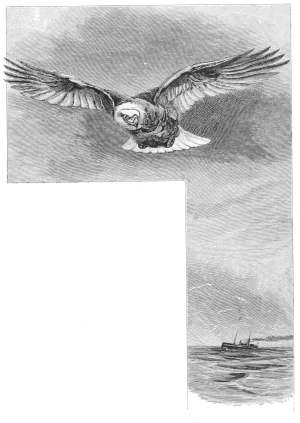 THE EAGLE OF THE SEA
THE EAGLE OF THE SEA
The largest eagle we have in Great Britain is the erne or white-tailed
eagle—the sea-eagle. Not that it fishes for its food; indeed, it seldom
eats fish unless it happens to rob another bird. But it levies toll upon
the sea-birds themselves, harrying the guillemot and puffin, and making
them its prey. By preference it builds upon the loftiest crags on the
stormiest shores, but if it can find rocks inland that are rugged
enough, and that overlook some{156} stretch of water where the wild-fowl
come, it will build its eyrie there, and scourge the surrounding country
(not sparing the sheepfolds), to supply its young.
They are not uncommon in the wildest parts of Scotland and Ireland, and
though, of course, persecuted everywhere, they succeed by their
extraordinary wariness and admirable judgment as to breeding-places in
keeping their ground. For the erne has the expert eye of an engineer for
an “inaccessible” spot, and having found one that nothing that moves on
feet can reach, it returns to it year after year, and brings out its
young in security. All that our poets have written of their eagles of
fancy may, for majesty in flight, be fairly applied to this bird. “When
the tempest’s at its loudest, on the gale the eagle rides,”—“playmate
of the storm,”—“triumphant on the bosom of the storm, glances the
fire-clad eagle’s wheeling form,”—“a swift eagle, in the morning glare,
breasting the whirlwind with impetuous flight,”—all these are quite
applicable to the sea-eagle, for folk say that no tempest that ever blew
could keep the erne at home. When the sea-birds are driven inland, the
ernes remain to wheel about as if enraptured in the storm-distracted
sky—and “like spirits hardened by despair, joy in the savage tempest.”
There is nothing mean about it. A law to itself, and therefore lawless;
stronger than any other fowl it ever sees, and therefore a tyrant; a
bird of prey, and therefore pitiless. Its eyrie is a citadel that cannot
be stormed, and the fierce-eyed{157} robber, seated on its eminence,
overlooks the townships of the gulls, and as it pleases takes manorial
tithe of the fish plunder they bring up from the sea, and of their
young,
“Voracious from the billows’ breast
Marked far away, his destined feast.”

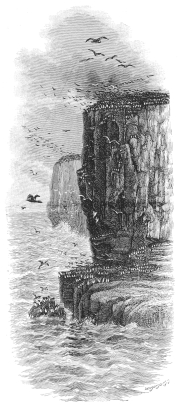 GUILLEMOTS
GUILLEMOTS
Its cry is a cruel, clear-ringing bark, very characteristic of the
fierce baron of the cliffs, and when circling in company a pair can be
heard yelping to each other until eye and ear together fail to catch
sight or sound of them. When they are young the sea eagles, as yet
unconscious perhaps of their{158} birthright of supremacy, roam about among
the moors and valleys, finding their food where they can, killing weakly
lambs, or joining the raven in an ignoble meal on carrion.
Sometimes, strange to say, this creature of vast spaces and dizzy
heights will nest in trees or even among reeds upon the ground. But its
characteristic haunts are the wildest and most rugged sea-cliffs, and
its hunting-grounds the rocky islets or tall upstanding bluffs and
“peopled rocks” upon which the sea-folk cluster in their colonies.
“The high and frowning scaur, the haunt of sea-fowl”
Mackay.
“The pregnant cliffs, the sea-birds’ citadels”
Montgomery.
“Yonder peopled rocks,
To whose wild solitude, from worlds unknown,
The birds of passage transmigrating come—
* * * * *
By Heaven’s directive spirit here to raise
Their temporary realm.”
Mallet.
No one, however indifferent he may be to the ordinary sights and sounds
of Nature, can maintain even the affectation of unconcern when visiting
for the first time the{159}

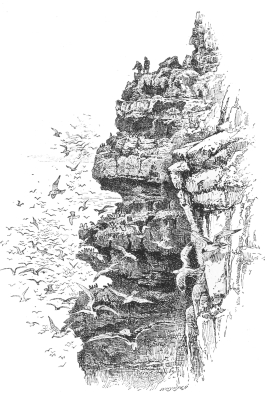 “THE SEA-BIRDS’ CITADEL”
“THE SEA-BIRDS’ CITADEL”
{160}
{161}
ledged and terraced rocks upon which the brave guillemots congregate. As
the boat approaches the sea-girt nesting-home of these delightful birds,
the cliff, looked at through glasses, seems garrisoned by a multitude of
little soldiers in black and white. They are standing to attention,
shoulder to shoulder, along every ledge, in level lines where continuous
foothold permits it, in little knots on every broader plateau, while the
summit is thronged. As the boat gets nearer you see that, besides the
white-breasted birds standing upright, there are just as many showing
their black backs sitting on the ground, or rather propped up on their
tails.
The latter are sitting-birds, for the eggs are so large as compared with
the mothers that they cannot be sate upon in the ordinary brooding
manner of other fowls. So the guillemot, when she wishes to sit, walks
up to her egg and then with her beak pushes it between her legs, and so
straddling as it were over it, she remains always at an angle, her body
resting against the egg, instead of nestling down upon it.
Long before the invaders’ boat comes into the shadow of the cliff, the
birds take alarm at the visitation, and at first by dozens, then by
hundreds, and finally by their thousands, spring upwards or dive
downwards from their places, and fill the air with an indescribable
murmur and flurry of wings—{162}
“Far adown, like snow
Shook from the bosom of a wintry cloud,
And drifting on the wind in feathery flakes.”
But the brave guillemots do not scream or cry out. Some of them grunt
their dissatisfaction at disturbance, and but for this they betray no
symptoms of annoyance or anger. Nor do they circle round their
threatened home, but rising from their places in a fast-thickening
cloud, they scatter for a minute or two through the air, and then settle
upon the sea and wait.
“There on the waters floating like a fleet
Of tiny vessels, argosies complete
Such as brave Gulliver deep-wading, drew
‘Victorious from the ports of Blefuscu.’”
Nothing, surely, can be more beautiful than the sudden uprising of many
birds, whether the scarlet battalions of flamingoes leaving in sumptuous
tumult the Egyptian marshes; the gay parrot flights when changing
feeding-grounds in the Australian bush, or this sight of our myriad
guillemots as with one accord they fill the air with their white wings,
and, beautifully stooping to the sea, spread themselves in a sheet of
pied dots upon the green water. And as you land you feel that all those
thousands of eager eyes are watching you, thousands of little hearts
thumping with misgiving at your intrusion. And here and there one bird
is sometimes{163} seen still bravely “holding the fort,” not with any
defiance, but a calm, good-soldierly courage that commands respect. And
now and again a mother will return, too anxious about her egg to
remember the risk to herself, or, remembering it, too anxious to care
about the risk; she comes with hurrying wing, and, before the very eyes
of the unmannerly trespasser, takes possession of her treasure, and
tucking it in between her legs turns her back upon the company and
trusts to Kismet for the result.
But those gaunt and grim-faced rocks, ribbed and wrinkled by the
wear-and-tear of sea and weather, are only the nurseries of the
guillemots, not their homes; for they live for nine months of the year
upon the dancing sea, never coming back to the solid crags at all. Early
in spring the first of them, the advanced couriers of the colony,
reappear from the ocean, reconnoitring their egg-towers, and then they
disappear again, as if to convey the news to the rest that the earth
still stands where it did. And then about May the guillemots begin to
come in earnest, and, astounding as the fact is, each bird actually
seems to remember the very spot upon which it laid its eggs the year
before, for we are told that the professional egg-hunters, who for a
score of years or more have regularly rifled the sea-birds’ terraces,
are accustomed to find, year after year, in particular places, eggs of a
particular shape, or size, or colour. For there are few eggs, if any,
that differ so boldly both in the ground colour{164}

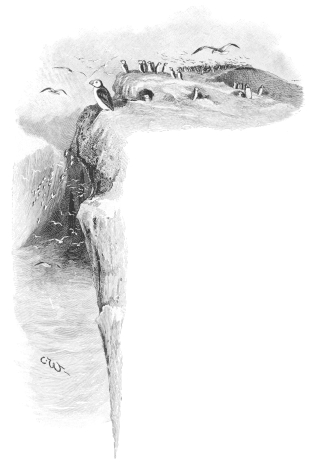 THE SEA-PARROTS AT HOME
THE SEA-PARROTS AT HOME
and the markings as the guillemot’s. Some have been taken spotless and
colourless, like a heron’s; others altogether sienna, as the kestrel’s
sometimes is; while between these two extremes of no-colour and
all-colour stretches as infinite a variety of markings as on the pebbles
on the shore. Perhaps the most beautiful of all are those where the
ground is a clear, bright green-blue, and the spots—large and
irregularly scattered, of a rich chocolate shading into brown-pink—make
on it a strong, bold, well-defined pattern,{165} without any of the
intermediate specks and streaks and zigzags that are characteristic of
this bird’s eggs. They are not laid in any nest, but on the bare flat
rock, sometimes protected from the violence of the wind by lying in an
indentation or where the rock is rough faced. But as a rule the
guillemot does not seem to expect her egg to be blown off the spot where
it is laid, and (though there are woful exceptions) she is right, for in
due time a dusky fuzz-ball, with a noble appetite for little fishes,
takes the place of each egg.
Then it is, alas for the poor parent guillemots! that the sea-eagle
comes on its broad pinions, yelping, and, swift as the wind, swoops
down, grazing the surface of the rock, and, regardless of the indignant
mob that rises in protest, flaps off with careless wing back to the
eyrie, where its eaglets are waiting for food. And every time the
sea-eagle comes and goes there is one fuzz-ball less than there was.
“She seeks her aërie hanging
In the mountain-cedar’s hair
And her brood expect the clanging
Of her wings through the wild air,
Sick with famine.”
But if tens are taken, thousands are left, and ere long the old birds,
finding their young ones restless, and fearing,{166}

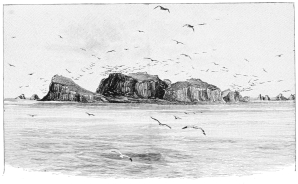 “WHERE THE SEA-FOLK CLUSTER”
“WHERE THE SEA-FOLK CLUSTER”
perhaps, as they may well do, that a fierce gust may sweep them over the
precipice on to ledges below, or that inexperience may tempt them too
near the dangerous brink, take the little ones on their backs—so the
climbers say—and fly down with them to the sea. Even if the chicks fall
off in the course of the descent, it does them no harm to plunge into
the water. It must astonish the youngsters to find themselves sousing
into the sea, but the next instant they have discovered that all is
right, and before their screaming mother has recovered from her concern
at the accident, they are swimming about merrily and enjoying their
first bath. And once in the ocean they remain there,{167}
“In the blue vale of water ’twixt the waves
Ever the same, yet ever changed; no mark,
No spot whereon to fix a local love,
No home to be remembered for its peace,
No shapely bough, well known and best beloved
Within the crowded forest,”
till the following May calls them back to the rocks and the cares and
pleasures of domestic life.
Man is, of course, the chief enemy of these sea-bird colonies, for in
the bleak and barren islands where they breed, human life could be
scarcely supported if it were not for the annual harvests of eggs and
young. The guillemots’ eggs are collected by tens of thousands. This
work commences at Flamborough, for instance, in the middle of May. For
the first nine days the climber has a good run of eggs; for the next
nine, eggs are scarce. At the end of that time all the birds who had
been first robbed have laid again, and he has a second run of large
hauls, averaging from two to three hundred a day. Then comes a second
“slack” of nine days, after which there is, as it were, the aftermath,
sometimes hardly worth the trouble and danger of gathering, sometimes
equal in value to the first harvest. The birds themselves, too, are
eaten, more especially the puffin.
St. Kilda has been described as “the paradise of puffins: every
available spot is burrowed and honeycombed with their holes, and the sea
is often black with birds.” Hither{168} in the nesting season come the
islanders—men, women, and children—and with short rods, at the end of
which are nooses of horsehair or string, drag the little “bougies,” as
they call them, out of their burrows. The birds are plucked (the
feathers being carefully put by for sale), cleaned, rubbed over with
salt, and hung up in strings to the roofs of the cabins, where the
peat-smoke partially “cures” them, and in this state they form one of
the chief and choicest items of the St. Kildan’s austere fare. But
altogether apart from its attractions at the “hardy Norseman’s” winter
board, the puffin is a very charming little bird. Its very quaintness
makes it engaging, for, whether you take it in profile, with its
grotesque beak in completest evidence, or full-face, with its queer,
owl-like look, its genuine unaffected comicality commends it to your
amused and kindly regard. For it is a most amiable fowl. It never seems
to quarrel with its kind, and even when it does the disagreement is
rather the make-believe of clowns than in serious earnest. The puffin is
almost voiceless, its usual sound being a purring noise, which, when it
is submitted to the extreme indignity of handling, becomes a kind of
half-hearted grumbling. No birds are more sociable than the
“sea-parrots”: they are never seen alone, and even in their colonies
they are not exclusive, admitting any other sea-fowl that likes to join
them to equal rights of citizenship. But you must not put your fingers
into its beak. Puffins are not called “parrots” for nothing.{169}
When breeding commences, the islands or headlands that they frequent
present scenes of most delightful activity.
“Above, around, in cloudy circles wheeled,
Or sailing level on the polar gale
That cool with evening rose, a thousand wings,
The summer nations of these pregnant cliffs
Play’d sportive round.”
Puffins are busy in all directions, digging out holes to lay their eggs
in, or putting last year’s burrows into thorough repair. Both parents
join in the work of excavation, taking turns, and while the one is
employed the other either sits with a most absurd expression of pompous
self-satisfaction, like a fat little owl-faced page, in close
attendance, or flits about in idle amusement in company with vast
numbers of the temporarily unemployed. Though so short-winged and
plump-bodied, they fly with singular speed, and wheel and circle with
great grace; but it is when they dive that they are at their best.
Regardless of height, they plunge head-foremost from their cliffs into
the sea, and, using their wings just as if they were still in the air,
literally fly under the water. But they never stay away long, for all
their thoughts are in those little burrows on the cliff, and the
constant flying to and fro of the anxious pairs, their whirlings in the
air before settling and after rising, keep the air alive with noisy
wings, and fill the scene with bustle and happy animation.{170}
So close sometimes are their nest-holes crowded that it is impossible to
walk without putting the foot in them, and it even happens that these
accommodating birds, when hard pressed for room, inhabit “semi-detached”
holes, and live two families in one. But here too falls the shadow of
the sea-eagle, and the poor parrots’ nurseries, when the young ones sit
outside their burrows, innocent of danger, pay heavy tribute to the
paramount lord of the northern sky. No erne’s nest is completely
furnished unless it be strewn with puffins’ beaks.
“The fierce sea-eagle
In port terrific, from his lonely eyrie
(Itself a burden for the tallest tree)
Looks down o’er land and sea as his dominion,
Or from long chase ascending with his prey
Feeds his eaglets in the noonday sun.”
Oddly enough, “the fierce sea-eagle” and the poor puffin find another
connecting link, less strained than that of being the eater and the
eaten, in the rabbit. The erne will often take up its quarters for a
time near a warren, and the sea-parrots do the same; but their reasons
are very different, for while the former goes among the coneys for its
meals, the latter does so to borrow the use of their burrows. And they
live together on apparent terms of amity, much as the burrowing-owl and
the prairie-dog live together on the Texan wastes.{171}

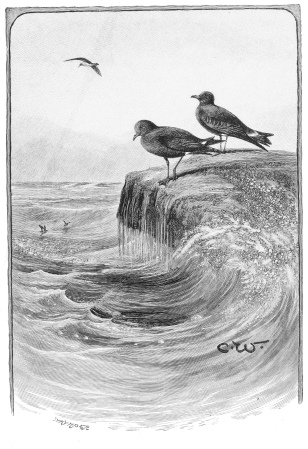 PETRELS NESTING
PETRELS NESTING
{172}
{173}
“Amidst the flashing and feathery foam
The stormy-petrel finds a home,
A home if such a place may be
For her who lives on the wide, wide sea,
On the craggy ice, in the frozen air,
And only seeketh her rocky lair
To warm her young and teach them spring
At once o’er the wave on their stormy wing.”
Barry Cornwall.
Nesting with them, in some of these haunts on the wild west coast of
Scotland, is found the stormy-petrel, the tiny bird which sailors, in
the old days of sailing-ships, held in such superstitious dread, and
which are still called Mother Carey’s chickens. Who Mother Carey was
Jack probably did not care, thinking only that she was a personage of
very evil intentions towards ships and those “who go down to the sea” in
them, and wishing, when he saw the little things running along the waves
that held the ship in chase, that she had kept her chickens at home. But
wiser bookmen tell us that the name comes from Mater Cara, quoting in
proof of it, that the French call the petrels “les oiseaux de Notre
Dame,” which may or may not be the explanation—most probably not. For
in the same dull way they tell us that Davey Jones’ locker means the
locker of the ghost of the{174} prophet Jonas, because West Indian negroes
happen to call a ghost “duffy!” All of which reads very much like
nonsense, worse nonsense indeed than Jack’s own phrases—which, like all
good fairy-tales, have most meaning when they have none at all.
However all this may be, the salts of the past thought the stormy-petrel
a bird of ill-omen, and they were not far wrong, for when all the other
birds, dreading the coming tempest, had left the ship, the chickens
remained.
“Still ran the stormy-petrels on the waves.”
Being alone, they became conspicuous, and though they had been there all
along, but unobserved when flying with larger birds, the sailors,
noticing them for the first time, thought they had just arrived as
heralds of the squall. For no weather, however bad, will drive the
petrels to shelter, and so deft are they with wing and foot, that when
the seas are driving “mast high” they may be seen paddling and skipping,
on tip-toe as it were, over the green curves of the breakers, or running
along them sheltered from the gale under their lee. And though it is no
larger, this tiny scoffer of the hurricane, than a starling, it is
curious to think how many hundreds of brave men have felt a sinking at
the heart when they saw the black diminutive bird skimming the furious
billows that pursued the vessel. Nowadays, going under steam instead of
canvas, the seaman does not trouble{175}

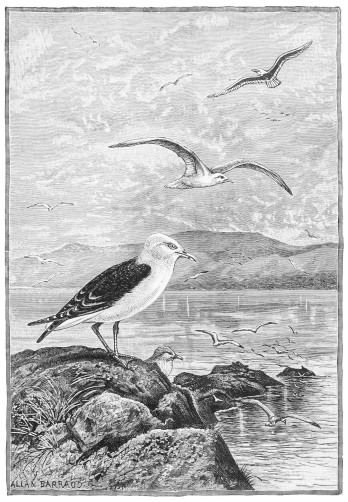 GULLS
GULLS
{176}
{177}
himself much about wind, and still less about the bird that our ancient
mariners used to think brought it.
What a shock for the old salts, who dreaded the killing of a petrel, to
hear that under the name “Blasquet chickens” they have been eaten on
toast, like snipe, and declared to be “delicious eating.” Yet such is
the fact; and seeing that the bird does not feed on fish, there is no
reason why it should not, unlike most sea-fowl, be palatable.
For the food of petrels, strange to say, is oil. At any rate, nothing
else is found in their stomachs, but where the oil comes from—whether
they collect it from the surface of the sea, or whether by some chemical
process of their own they convert other material into oil—no one can
say with certainty.
Oddly enough, too, the little stormy-petrel in its breeding haunts does
not fly by day, but feeds its young at night; and here, again, reason is
puzzled for an explanation. They lay their eggs in crevices of the
rocks, in heaps of débris, or old rabbit-holes; but these are only to
be found by searching, as there are no birds on the wing while the sun
is shining, and they do not, like all others, betray their nurseries by
going to and fro in the daylight with food. What strange contrasts! For
more than nine months of the year the petrel is “the playmate of the
storm”—
“Where the ocean rolls the proudest,
Through the foam the sea-bird glides”—
{178}
always in attendance upon the tempest, an omen of ship-wreck and
sea-terror:
“The petrel telleth her tale in vain,
And the mariner curseth the warning bird
Who bringeth him news of the storm unheard;”
and then for the rest of the twelvemonth it lurks in little holes in
rocks, under heaps of stones, in rabbit-burrows, coming out only when it
is dark, a bat-like creature of dusty crevices and dusky twilight,
mortally afraid apparently of everything that moves by day, and shunning
on land the men whom at sea it seemed to triumph over and to doom.
And how terrible the declension from being “Mother Carey’s chickens,”
mysteriously shaken out of the old dame’s lap in the sky to bring men to
their death by drowning, to “Blasquet chickens,” picked out by ragged
little islanders from the chinks in which they are hidden, and then
eaten by tourists and townsfolk, fried upon toast!
Nor are these birds’ only enemies human ones, for in the predatory
black-backed gulls they find untiring and cruel persecutors. As
persistent and as cunning as crows, they loiter about the nesting-places
of the smaller birds, searching out their eggs and young, and chasing
the parents. Even large birds, like the cormorant, dare not leave their
nests unprotected, as the air above is full of keen-eyed, black-backed
gulls, and every eminence has its patient, sinister{179}

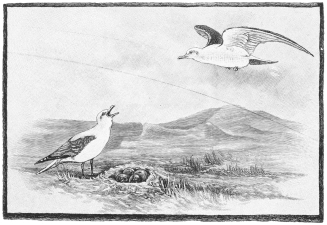 NEST OF LESSER BLACK-BACKED GULL
NEST OF LESSER BLACK-BACKED GULL
{180}
{181}
watchman waiting for some incautious mother to leave her eggs exposed,
and in a twinkling the thief pounces on it.
Their courage, too, is extraordinary. The nest that is shown in the
illustration is not in any of the usual sites that this gull selects,
and is chosen for that reason, as showing the fearlessness of these
birds, for it is built in a sheep-walk which the woolly folk had
frequently to traverse, and was found out by the shepherd seeing all his
flock, as they passed in single file, jumping at the same spot. On going
to find the reason for this agility, the hen-bird was discovered sitting
on her eggs.
Of all the gulls, this is perhaps the least of a sea-bird. For it lives
almost altogether on land, searching the beach and rocks for dead fish
and other food cast up by the tide, and boldly coming inland to feed in
ploughed lands, or follow the course of rivers, or pick up a living in
harbours and docks, going back to the water to rest and sleep. Very
different is the scene when the visitor, landing on one of their
breeding-rocks or islands, disturbs the hosts of the lesser black-backed
gulls, to that when he landed among the uncomplaining puffins. For the
gulls resent the intrusion with wild cries and threats, and, instead of
flying away, patiently disconsolate, to wait for the intruders’
departure, wheel and whirl overhead, with angry clamour and noisy wings,
making believe to swoop down on the trespassers, and shouting at them to
go away. And they have good{182} reason for their indignation, for their
visitors carry off their eggs by the boat-load for sale among the
hard-living islanders.

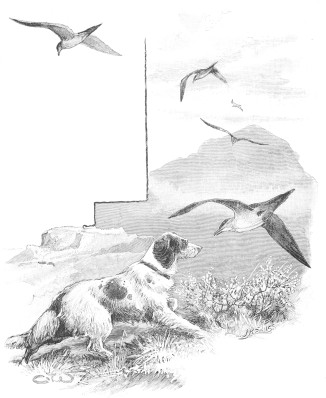 AMONG THE SKUAS
AMONG THE SKUAS
But the black-back is a mischievous and predatory bird, doing infinite
injury to more valuable species, like the eider-duck, whom it harries
without remorse; and so one{183}

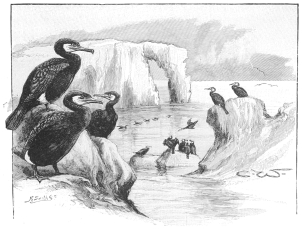 A COLONY OF CORMORANTS
A COLONY OF CORMORANTS
can read of its eggs being cooked by the million without any keener
feeling of regret than if they were apples. And, after all, the
wholesale robbery of their nests does not reduce their myriads, for more
than enough are hatched every year to fill the gaps caused by death.
Being, too, so courageous, the gull escapes persecution by its larger
companions, and even the sea-eagle prefers, with so large a choice of
more timid victims, to leave such obstreperous birds alone. When
threatened by the great bird of prey they join for the common defence,
and the eagle is often seen, at long{184} distances from the
breeding-places, pursued by shouting gulls, and ignominiously mobbed out
to sea.

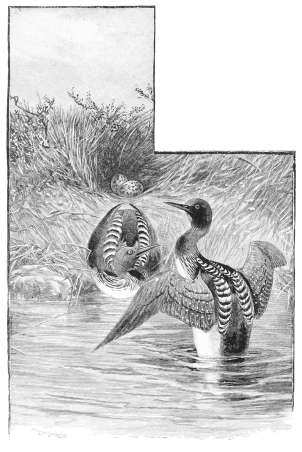 BLACK-THROATED DIVER
BLACK-THROATED DIVER
With them, on these retaliatory sallies, goes that most intrepid of{185}
sea-fowl, the skua—one of the many birds that the sailor calls
“molly-hawks,” and that the lesser creatures dread like a bird of prey.
For such it really is, living chiefly upon the fish the other birds have
caught, upon the birds themselves, and during the nesting season upon
the eggs and young of all species indiscriminately: so reckless in
attack that nothing on wings dares to oppose it, and so powerful that
full-grown gulls, if they persist in the fight, succumb to it. He laughs
the sea-eagle to scorn, challenging it by loud squalls to a duel. But
the erne knows better than to join in a conflict from which neither
honour nor profit can come, and spreading his great square-cut wings to
the breeze, drifts swiftly away from the spot over the moorland that the
skua calls its own. Where the herring-fishers are at work, there the
skua is sure to be, gobbling as much as it can find for itself, and
chasing all the other birds to make them drop their shares. Nor when
there are eggs in its nest does the skua hesitate to threaten human
beings that approach it, and indeed actually to attack them; while there
are few dogs, if any, that have ever encountered an angry skua, and had
experience of its sharp beak and battering wings, that care to face the
fierce fowl a second time.
{186}
{187}
CHAPTER VII
The Kingfisher—The Mystery and Folk-Lore of the Halcyon—The Water-Vole
at Home—In the Water-Meadows—The Moorhen and its Haunts—The
Reed-warbler—The Sedge-Warbler—Music of the Summer Nights—Waking the
Sun
{188}
{189}
CHAPTER VII
“The long-leaved willow, on whose bending spray,
The py’d Kingfisher, having got his prey,
Sate with the small breath of the water shaken,
Till he devoured the fish that he had taken.”
SO writes Michael Drayton in the sixteenth century, and how true an
observer of Nature the old poet was is proved by the words of our latest
ornithologist: “It alights on some twig bending over the stream, its
weight causing it to swing gently to and fro, whence it scans the young
trout sporting in the pool below, and suddenly it will drop into the
water, and almost before the spectator is aware of the fact, is back
again on its perch with a struggling fish in its beak.” Nor must the
meaning of Drayton’s “py’d” be mistaken, for in his day, and indeed much
later, anything of more than one colour was called pied, so long as
gaiety of tint was the result of the combination. So Shakespeare calls
the daisy “pied,” and Ben Jonson the rainbow.
But to come back to our kingfisher, “famousèd for{190}

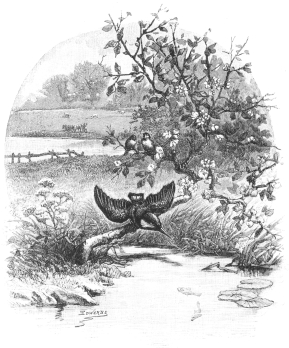 THE KING OF THE POOL
THE KING OF THE POOL
colours rare,” sitting upon its twig with the tiny fish in its beak.
Only, however, for half an instant, for the bird raps its little captive
sharply upon the twig, perhaps more than once, and then it is gone where
all little fishes go{191} that kingfishers chance to catch. Sometimes,
indeed, it is not content to swallow the wee thing in a commonplace way,
but, as the toucans often do with their food, must needs throw it up
into the air, and catch it with open throat head first as it falls. And
if you listen you will hear the kingfisher compliment itself upon its
cleverness with a congratulatory little chirrup. So, too, when it misses
its aim at a passing fish—for it does miss it sometimes—it comes back
to its perch with a cheery little “peep-peep,” as much as to say “Never
mind.” And when it flies off down the stream, startled by your sudden
coming, you may, if you have quick ears, hear it comforting itself in a
nervous sort of way with a succession of “peeps,” but if you go and hide
behind the hedge or a bush, you will very soon see it returning, a swift
flash of orange and blue, and lo! there is the kingfisher back again
just where you first saw it, on its pliant twig, “with the small breath
of the water shaken,” and its clever eye fixed upon the water beneath.
For, like flycatchers, shrikes and other birds, it returns, if it can,
always to one “post of observation,” and just as the dragon-fly at the
edge of the stream keeps flying back to the same reed after every
excursion, so the kingfisher, though you have just seen it go darting
off like a blue gem on wings, in and out of ever so many twists and
turns of the little stream, comes back, and in a surprisingly short
time, to the very spot it started from.{192}
This habit brings many of them to their death, for there are still, in
spite of all the appeals of the humane, the protests of lovers of
Nature, and the threatenings of the law, numbers of men who call
themselves fishermen who try to do these lovely birds to death. That
“halcyons” eat fish, and nothing else if they can get enough of them, is
beyond all doubt, and when there are five young ones in the nest in the
bank, they must kill a great number. But granting all this, the fact
remains, that the man who would go about to compass the killing of a
kingfisher is not an angler of the best type.
However, in spite of them and all other enemies, this sweet ornament of
our rivers is still abundant, and there is no secluded stream where the
lover of Nature may not enjoy himself with the sight of it at its work,
patient and clever, or admire its rare beauty as it flashes up and down.
“There came
Swift as a meteor’s flashing flame
A kingfisher from out the brake,
And almost seemed to leave a wake
Of brilliant hues behind.”
Indeed, it takes a very quick eye, sometimes, to make out the form of
the bird as it passes: all that is seen is a sudden trail of sapphire
blue, which, meteor-like, vanishes{193} before you have time to say “There
it is.” And what is its real colour? Sitting opposite you on its perch,
the throne from whence this little king surveys its subject fishes, the
bird is a beautiful chestnut and white, and its legs and feet are coral
red. Then it dives, and as it goes down its plumage flashes a pure,
clear blue, and as it comes up, taking the light at another angle, it is
a lovely mixture of azure that is half emerald-green and of
emerald-green that is half azure. For all these colours go to the
painting of a kingfisher; but, as a rule, when it is flying from you it
is simply a streak of sapphire. The young birds of the first year have
their colours fainter, but even then are sweetly pretty, and there are
not many sights in our wild Nature more completely attractive than that
of the young brood sitting about close together on the roots among which
their nest has been tunnelled out, while the old ones fly backwards and
forwards, fishing for them and feeding them. And whatever happens, they
all keep on saying “Peep-peep” to one another, in the happiest,
contentedest way conceivable.
Their nest is a yard back in the bank. It takes the old birds two or
three weeks to dig it out (though sometimes they will begin housekeeping
in some convenient hole that the water-rat has left or the sand-martin
deserted), and at the end of the tunnel, on a flooring of fish-bones,
are laid the exquisite white round eggs, with shells so translucent that
when they are fresh they look more pink than white.{194}

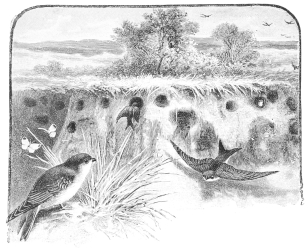 THE CAVE-HAUNTING MARTLET
THE CAVE-HAUNTING MARTLET
Yet poets and others who draw so many morals from the pearl being found
in what they are pleased to call a “foul” oyster, never allude,
strangely enough, to Nature’s pretty lesson of the kingfisher, which
comes arrayed in all its loveliness of plumage from the very dirtiest of
holes. For it is a sad fact that kingfishers have the most magnificent
contempt for everything like “sanitary arrangements;” yet once they have
left their nests they are the chiefest jewels of the stream, among the
prettiest things to be seen{195} in all a summer’s day. Where they built was
apparently once a mystery, for in the long-ago days of Greece and Rome
the “halcyon” was supposed to go off somewhere near Sicily and other
isles, and nest upon the open seas; and so fond were both pagan men and
pagan gods of the little bird, that—so poets pretended—the seas were
never stormy while the halcyons were nesting, and the word has passed
into our language as the symbol of calm security and rest and peace. So
in Keats:
“O magic sleep! O comfortable bird!
That broodest over the troubled sea of mind
Till it is hushed and smooth.”
And in Shelley:
“Far, far away, O ye
Halcyons of memory,
Seek some far calmer nest
Than this abandoned breast.”
And in Milton and Dryden, and Kirke White and Coleridge, and ever so
many more. Another belief, which, strange to say, still holds its own in
England, is that a dead halcyon hung up will turn its beak always in the
direction of the wind. So Shakespeare says of courtiers who “turn their
halcyon beaks with every gale and vary of their masters”; and Marlowe,
before him, asks “How now stands the wind? Into what corner peers my
halcyon’s bill?”{196}
But oddest of all is the following superstition from an English book of
the twelfth century:—“These little birds, if they are preserved in a
dry place, when dead never decay; and if they are put among clothes and
other articles, they preserve them from the moth and give them a
pleasant odour. What is still more wonderful, if when dead they are hung
up by their beaks in a dry situation, they change their plumage every
year, as if they were restored to life, as though the vital spark still
survived and vegetated through some mysterious remains of its energy.”
None of our British birds probably feels a severe winter more keenly
than the kingfisher, for when the streams are frost-bound and icicles
hang from the willows where it used to perch so blithely in the summer
days, the little creature is in a desperate plight. Insect-eating birds
have a last resource in berries and vegetable food, but the kingfisher,
when the streams are frozen and the ponds all ice-locked, has nothing to
fall back upon, and so he wanders off to the seashore and the mouths of
rivers that are still open. “Even here,” says a writer, “the poor
kingfisher often fares badly, and after an unusual spell of frost
numbers of them are picked up starved to death. Sometimes they are found
frozen to the branch on which they have been sitting.” But in open
weather its life is as joyous as any bird’s can be, and is passed among
the prettiest of scenery.
You will note, or may fancy that you do, that it is{197}

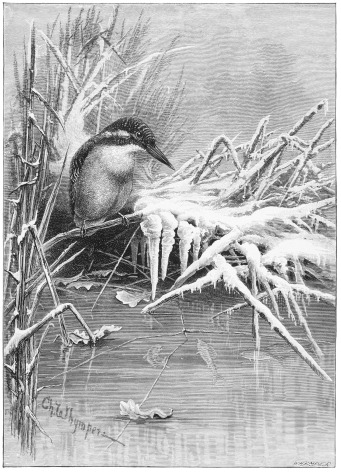 “WHEN THE PONDS ARE ALL ICE-LOCKED”
“WHEN THE PONDS ARE ALL ICE-LOCKED”
{198}
{199}
always the most delightful bends of the streams, the most charming nooks
and corners of the waterways and pools that the kingfisher haunts. Where
the scenery is open and tame, he is only a passer-by. But where his
beauty adds the one charm of life, and beautiful life, that was needed
to make some special “bit” of loveliness complete, there the kingfisher
lives. It is a sweet little poem, this bird. Does it see any of the
beauty that we do in these archways of willow and alder, this exquisite
embroidery of forget-me-nots upon the brink, this clump of yellow flags
and fair tall willow-herb? One could almost imagine that it does, so
careful is it to pitch its camp just where Nature is at its best. Here
the banks are flowered and prettily uneven with mossy stumps and roots
“peeping out upon the brook.” The moor-hen is at home here, and that
delightful, harmless little beast the water-vole.
I remember once seeing a water-vole sitting up at its front door in the
sun, nibbling its crisp salad of young reed-shoot: on one side of it
grew a tuft of “faint sweet cuckoo-flower,” and just above it was a
great rosette of primroses, and I thought I had never seen anything more
enchanting than this quiet little touch of innocent and pretty spring.
One of them has his hole yonder where there is a little overhanging
bulge in the bank, and that little platform which seems neatly laid with
rushes is his dining-room, and from it, running either way, you can
easily trace the small animal’s{200} regular path to points where he can
slip into the water quietly. If he were to jump in off his doorstep he
would make a splash: a great indiscretion in a water-rat. So he toddles
off to the right or the left as his fancy takes him, till he comes to a
conveniently shelving place where he can take to water without noise.
Under that green moss-furred root, over which his pathway so clearly
goes, is the kingfisher’s nest. The hole runs in straight for about
three feet, and at the end is “the nest,” and the little birds sitting
in it can tell by the stoppage of the light at the entrance that father
or mother has come back with a fish, and they hurry forward, crouching
low, with out-stretched necks (for the tunnel is only three inches
high), to get the food first. So the strongest or hungriest gets fed
first, and when it has had enough it stays behind when the next race to
the opening takes place, and the weaker or lazier take their turns till
all are satisfied. And this is the simple explanation of that which so
often puzzles people—“How do the old birds know that all the young ones
have been fed? can they count, or do they know them all one from the
other?”
No, they cannot count, and they do not know one from another. If you
watch a bird at a nest, it gives the food to the nearest mouth: it never
picks and chooses. But young birds know when they have had enough—for
the present. If you are feeding a young bird you have taken from the
nest,{201} how ferociously it takes the first bit, and the second, and
perhaps the third; and then how utterly and suddenly its appetite
collapses! It refuses, in the most dogged and sulky way, to open its
beak though you tempt it ever so much. It has had enough, and it knows
it, and isn’t going to burst for you or for anybody else. It is just the
same in the nest. The first two or three pieces of food may all follow
one another down the same throat, but next time the mother comes there
is one mouth shut tight. And so it goes on. One by one the mouths are
shut up, and the mother comes at last with a titbit, and finds every one
of the little ones asleep, on full stomachs, and as haughtily regardless
of her and her provender as if they would never need feeding any more.
So the mother eats it herself, and sits down on the top of the sleepers.
This is the whole secret of the mystery. While the little birds are
hungry they keep on asking for more: as soon as they are stuffed full
they convey that information to the parents by holding their tongues. So
all get fed.
And a word here as to that odd superstition which is still current, that
the British Museum will give “a hundred pounds for a complete
kingfisher’s nest.” Every year the “authorities” are written to by
people in the country offering to send them one at the price, but of
course it was never offered, and indeed a kingfisher’s nest has not been
wanted, since the beautiful section of a river-bank, with the nest, and
young, and old ones all complete, was set up in the Bird Gallery at the
British{202} Museum in 1883. But the kingfisher’s nest is not the only
article that a deluded public seems to imagine the British Museum is
still pining for, for as a letter to the Times by Sir J. Flower in
1894 tells us, offers are regularly received of tortoise-shell tom-cats
at the most exorbitant prices, and inquiries continue to come in, asking
if it is true that the Museum has offered a hundred pounds for “an
entire cigar-ash.”
Nowhere can the lover of Nature find more to spend his time over than in
the pretty haunts of this pretty bird. As a schoolboy I have spent many
hours in water-meadows watching the bird-life about me, and, sitting on
some mossy stump in the middle of the marsh-marigolds or on some rail
that straddled across the water, enjoyed the little spectacles, comic
and serious, that various companies of amateurs—moor-hen and water-rat,
bunting and reed-warbler and weasel—presented for my entertainment.
My visits to the kingfisher’s osier-beds were often really Platonic.
There were no eggs to be taken that I had not enough of and to spare in
my collection. Albeit the chance of a cuckoo’s egg always made looking
into every nest I found “a pleasurable expectation,” which was just
often enough fulfilled to make the quest a perpetual hope.
Not that the keeper—“arbiter of this terraqueous swamp”—would have
believed me if he had caught me, and no monkey in Brazilian forests
hated the jaguar more{203}

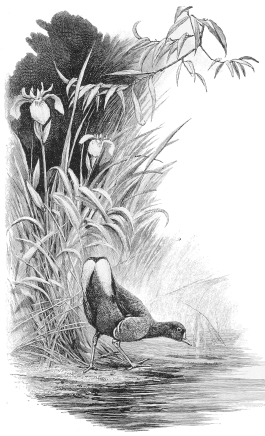 DID I HEAR SOME ONE?
DID I HEAR SOME ONE?
than I hated the keeper. Sometimes just as I was really happy, and doing
nothing more criminal than watching a water-rat that was trying to
balance itself on an arrowhead stem while{204} it reached up to the seeds, I
would hear his detestable splashing—stealthy, he thought it, no doubt,
the clumsy wretch, but noisy enough to warn my Red Indian ears a long
way off—and I had to go. His own squelching feet and big body forcing a
way through the osiers, which whipped his face as he went, hid the noise
of my retreat as I slipped along like some fox, hardly scaring the birds
that I passed, and cunningly stepping from point to point so as scarcely
to make a splash. And so out at the other end and up into the high road
and home as hard as I could run.
On one occasion, all but taken by surprise, I suddenly heard the
keeper’s step close by, and had to slip into the water and sit there,
like a coot, with only my head above the surface, and that half-hidden
by reeds—and he passed, oh! so close to me, stopped for an instant to
wonder to himself, perhaps, why the water was rippling so, and then went
on, so cautiously, so cunningly, knowing that a boy was somewhere about,
and expecting to pounce on him; while I just as cautiously rose from my
sloppy, weedy lair, and crept off in the other direction, and got into
the dusty road, my boots squelching dreadfully, and making as I jogged
along (as Ben Jonson says) “great S’s like a watering-pot.”
And what was there in the osiers to amuse a boy? First of all, there
were the water-rats, always funny, but never so comical as when cutting
reeds. You would see one go down under the water, and the reed would{205}
begin “twiddling” and quivering in response to the sharp brown teeth at
work below, but instead of falling, the reed would lean up against the
next one, and when the vole came up to look for it, it would not see it,
but it used to say “Bless me, how odd!” and go under again, and begin
cutting another one down, bothering the dragon-fly who was sitting on it
very much by the vibration. Then it would come up again, catch hold of
it, and swim away to the stump where its hole was, and drag it up and
cut it into lengths like an imitation beaver making a dam, and stop
every now and again and look round, though there was only myself and the
dragon-fly to appeal to, as much as to say, “There! that’s the way it’s
done.” And if there were two of them, to see the way they stroked each
other’s cheeks with their tiny paws, just as the wallabies do, putting
one hand on each side of the other’s face, was as pretty as could be.
Then there were the dabchicks, who came swimming along under water right
over one’s feet, looking like bags of bubbles, or as if they were all
covered with globules of quicksilver, and stopping to eat something at
the bottom, as if they were fish, not birds. Then they would come to the
top for air, catch sight of me, and with a horrified little “Goodness
gracious!” bob under water again and go off straight down the little
canal, a streak of bubbles.{206}
“The Coot bald, else clean black that whiteness it doth bear
Upon her forehead starred, the Water-hen doth wear
Upon her little tail, in one small feather set.”
Drayton.
“There have I watched the downy Coot
Pacing with safe and steady foot,
The surface of the floating field,
And though the elastic floor might yield
In chinks, and let the water flow
In beads of crystal from below,
Yet was the tremulous region true
To that rough traveller passing through.”
Faber.
Above all, there was the moorhen, a bird that one can surely never be
tired of watching, it is so full of quips and cranks. It has a little
red wafer on its nose and queer little patches of white under its tail,
which it keeps on flicking as it goes in a comical automatic sort of
way, in time with its steps, as if its tail were a kind of pedometer
measuring off the distances it walks. And when it is in the water
swimming, it jerks its head backwards and forwards, as if doing so
helped it along and it could not help jerking every time it kicked out
its legs. And when it is in the water, how it bobs about! You can never
depend upon it for an instant, going in the direction it started for;
something{207} or other is sure to attract its attention, especially if it
has its brood behind it, and its mate is on the watch, making a great
show of vigilance and unnecessary sagacity.

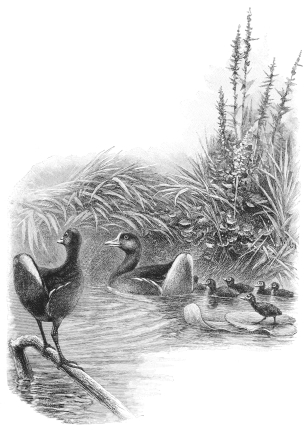 THE WATER HEN
THE WATER HEN
The young ones—trying to
follow the mother’s movements as she darts at a fly here, pecks at
something there, suddenly stands on her head{208} to fetch something up from
down below, or makes an unexpected dash at an insect that is skimming
across to the reeds—twist and wind about and get in each other’s way,
like a squad of badly-managed boats, that keep on fouling and ramming
one another, and all the time keep up a feeble little chorus of
disconsolate cheep-cheep. But they are learning their lessons all the
time, and it is delightful to watch their imitations. They gape at the
passing flies, make sudden little excursions, three inches at a time,
after something they think they see, and ridiculously attempt to dive,
as they notice their mother do. But they are so light and so weak that
the resistance of the water is too much for them, and all they can do is
to put their heads under water and kick in the air with their legs,
exactly like little boys trying to turn somersaults on the grass, but
only getting half over.
Indeed, whatever the moorhens are doing, they are interesting, and there
is an alert sprightliness about them when in company that is infinitely
amusing. When an old bird is alone (it is impossible to tell cock from
hen) it is very self-respecting and purposeful. As it goes upon the
grass there is a high-stepping, aristocratic gait about its walk that
even the affected little flirt of the tail accentuates, and when he is
in the water, with some object-point in view, he swims both fast and
straight. And what beautiful homes they find, where the yellow iris
grows, and the marsh-marigold, and tangles of forget-me-not, where the
stream{209} filters in the shallows through beds of cress, or deepens into
pools, so that the water-lily may spread its pads at ease. And there are
beds of bulrush and feathery-headed reeds, into which they paddle; and
if you do not mind wet feet, you can go and look right along the little
“pleached” alleys they have made for themselves, to the end where the
nest, a heap of rushes with a comfortable hollow smooth-lined with finer
material, closes the passage. No bird nests more becomingly than the
moorhen, or more picturesquely; and if it were not that I remembered the
enjoyment I used to find in wading after them, and (with some shame be
it said) the excellence of the eggs when hard-boiled cold, I should look
back with more repentance than I do to the wholesale manner in which I
used to fill my handkerchief full of the large speckled eggs, and
triumphantly distribute them along the table at tea-time. Alas! for
Clare’s supposition that
“At distance from the water’s edge
Or hanging sallow’s farthest stretch
The moorhen builds her nest of sedge
Safe from destroying schoolboy’s reach.”
While I robbed her—a moorhen by judicious robbery can be made to go on
laying twenty eggs and upwards—the mother would get into the water
under the shadow of the {210}reeds, and with only her head out, watch the
spoliation in progress. And sometimes, coming upon her asleep, perhaps,
on her nest after her young ones had hatched, it was a sight to see how
suddenly she vanished, and how the chicks scrambling out after her in a
twinkling, stood on their heads, thinking they too had dived out of
sight. I have often taken up the little fluff-balls in my hand, and
wished to take them home, but kinder thoughts have supervened, and I
have laid them back on the water and watched them paddle off to the
shelter where the poor mother, only her red-spot beak showing above
water, crouched, clucking nervously in stage whispers, “This way, this
way.”
Sitting at ease one day watching a family party, I became aware of a rat
that was watching them as well—a common brown farmyard rat—that, with
so many others of his kind, haunt osier-beds and streams, and, by their
depredations, bring discredit upon the water-vole. The miscreant was on
the bank; the “moor-chickens” were paddling in a dutiful, unsuspicious
fashion behind their mother, when one of them, coming to some weeds,
must needs scramble on to the top, to show what a clever bird it was.
Something it found there interested it for an instant, and meanwhile all
the rest went on. Then I saw the rat slip into the water, and swim
towards the little platform of weeds; and the chick saw it too, and
wondered, no doubt, what it was. But it decided that the thing did not
look quite right somehow, and got into the water to follow its brothers{211}
and sisters. If it had known what was behind it, and had paddled at its
best pace, it would have beaten the rat easily; but it was in no hurry,
and went slowly across towards the bank. Close behind it swam the rat.
The little bird was doomed. In my cap I had some dabchick’s eggs, and I
took one out, and trusting to luck to miss the bird, threw it at the
beast. There was a smart splash in the water, just where I had hoped to
see it, close to the rat’s nose, and the next instant the chick was
swimming for dear life after its mother and the rat was scrambling up
the bank. I wonder what each of them thought of that dabchick’s egg?
Nothing so “wonderful” as that ever happens to us in our lives. With
birds and beasts it happens every day. But they do not go crazy at the
constant repetition of miracles, for, fortunately, they do not
understand them.
“Fen sparrows chirp and fly to fetch
The withered reed-down rustling nigh;
And by the sunny side the ditch
Prepare their dwelling warm and dry.”
Next to moorhens, the most constant companion of the visitor to the
sedgy margins of a pond or osier-bed is the reed-warbler. To many eyes
the reed-and the sedge-warblers look alike, and to most ears their songs
sound alike. Nor in their comings and goings and general behaviour is
there much to distinguish them as they creep about in their shady
coverts{212}

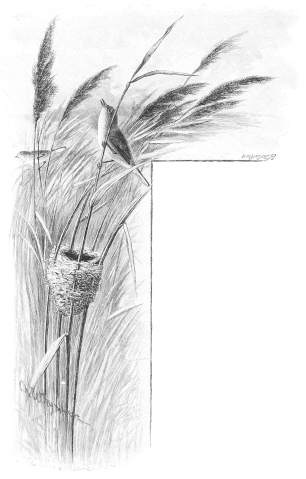 THE REED MUSICIANS
THE REED MUSICIANS
or momentarily flit across some narrow space, or with a flight like a
flying-fish’s in the water, suddenly appear on the surface of the reeds,
skim their level tops, and as suddenly drop down out of sight again.
They come to England together, and together seek the same haunts. The
only way to make them betray themselves is by throwing something among
the reeds, when each of them will at once protest, sometimes scolding
like a{213} whitethroat, sometimes breaking out into a bold, beautiful song.
Each bird, too, occasionally forgets its shyness, and coming out from
its retreat perches well in sight and fearlessly sings its loudest. But
their nests are unmistakable; for while the sedge-warbler always builds
upon some support, the reed-sparrow hangs its nest between supports, but
never upon them. Yet as you loiter near their pretty nesting-places, it
does not matter much which of the birds you disturb, for either will
sing for you as long as you remain, and it is a charming sight to see
the little olive-green bird clinging to a reed or a willow-withe, and
with stretched throat singing with all its might. A very little wind
makes it sway, and this, with the bird’s strange ventriloquist powers,
makes the song seem to sway, too, and as you watch it, the small
creature grows quite mystical, with its notes, now near now far, and its
beautiful little body swinging to and fro in the chequered shadow of the
tall plumed reeds. And sometimes, while he is singing, the hen-bird, as
if excited by his song, begins too, in a harsher voice but not
unmusical, and once started you will hear the duet going on behind you
long after you have left. In the warm evenings, when out with my net
moth-hunting along the river side, I have often heard them singing among
the sedge and willows, and later, coming home in the dark, have found
them still in full song.
As a matter of fact, our short nights in summer have{214} often as much
melody as the days. Not so much chatter and chirruping and twittering,
but quite as much song, for there are none of our singing-birds that,
when the fancy takes them, will not add a beauty to a fine night by
their music. Sleeping out of doors (I do so as often as I can get the
chance), I have at one time or another heard them all, the cuckoo and
the owl together, the robin and the nightingale.
There is one exception, the skylark, and inasmuch as I have never heard
it singing in the dark, I always consider it either the sleepiest or the
most methodical of all birds. To call the lark lazy and a “slug-abed,”
to use Shakespeare’s word, sounds, I know, like treason, for has not
every poet from Chaucer onwards told us that it wakes the day; and is
not “to rise with the lark” a household word for being up very early?
But if we come to prosy facts, they are all dead against the skylark,
for by the time it begins to think of awaking the day, the other birds
have been already doing it for hours. Of course, it may be that the sun
does not pay any attention to the other birds, regards them as
unlicensed watchmen who have no business to try and wake him up before
his proper time, and that he waits for the lark, as the only genuine
certificated waker-up of the firmament, before he gets out of bed.
Robins and blackcaps, woodlarks and reed-warblers are perhaps mere
irresponsible amateurs. The skylark is the one properly diploma’d
professor. He alone really knows when{215} the sun ought to be awakened; the
rest only think they know.
To tell the truth, if Phœbus were to attend to every bird that
chooses to call him, he might just as well breakfast overnight; lie down
on the sofa with his hat and boots on, or not go to sleep at all.
Moreover, the skylark has the merit of punctuality and is regular. He is
always up and singing by the time there is light enough to see him by.
The sun can rely upon him, which is more than can be said for the robin,
who, though I do not wish to say anything about him that might injure
his character, sings in the mornings decidedly tipsily, as if he had
been out all night at a party and were just coming home “with the milk.”
But no treason of the robin! More than any other bird it has endeared
itself to our race, and our earliest literature bears witness to the
national affection for “the charitable ruddock.” Somehow or another, the
pretty fancy has attached itself to the bird, that it “covers the bodies
of unburied men,” and long before Shakespeare utilised it to beautify a
passage it had passed into the proverbs of the country. But even those
who do not remember the charming legend with which the story of “The
Babes in the Wood” familiarises every English nursery, love the robin
for its beautiful confidence in man and woman, and for its brave-hearted
song. While the trees are still bare in spring, and before the thrushes
and blackbirds have begun to try{216} their voices, the robin chants his
cheery song, so full of bright faith and gladsome hope that the hearer
cannot but take fresh heart on hearing him sing of better times. In
summer, when “varied music burthens every bough,” the voice of the
little preacher of the wood is lost for a while, but by-and-by, when the
songsters all have gone southward with the sunshine, and the chill rain
drips from empty boughs upon the russet drifts of autumn leaves, the
robin mounts the vacant choir, and out of the fulness of his own brave
little heart utters his sweet brief canticle, “thanking God” so it seems
“for a life so fair,” and bidding all the sad who listen to him to renew
their hopes and be light-hearted, to continue in their joy. And so to
December and the end of the year, which the robin-redbreast always sings
out with a happy Christmas carol.{217}
INDEX
A,
B,
C,
D,
E,
F,
G,
H,
I,
J,
K,
L,
M,
N,
O,
P,
R,
S,
T,
V,
W,
Y.
Among the Osiers, boyish sport, 202-5
Artifices of birds, 63
Birds:
of the seasons, 13, 14
calendar of, 47
of the months, 54
little noticed, 101
of the sea, 158
flight of coloured, 162
in the poets (see Poets)
Bird-pests, 104, 105
Bird-voices, expressiveness of, 113
song of caged birds, 33, 34
Bittern, its folk-names, 48
Black-backed gull (see Gull)
Blackbird, 30
curious folk-belief about, 31
what becomes of its surplus numbers, 31
its nest, 32
its “piping,” 33, 34-37
Blackcap, 101
its song mistaken for the nightingale’s, 102
its eggs and nest, 117, 118
“Blasquet chickens,” 177
Boyish sport among the osiers, 202-205
British Museum, curious notions as to what it wants, 201, 202
Caged Birds Singing, 33, 34
Calendar of birds, 47
Cat concerts, 35{218}
Colour in flights of birds, 162
Coot, 50
Corn-crake, 113
its cry, 114, 117
Cuckoo, 99
its foster-parents, 100
food and song, 101
Curlew, folk-lore of, 49
Cushat (see Wood-pigeon)
Dabchicks, 205
“Davy Jones’s locker,” 173, 174
Dotterel, 64
its note, 67
Eagle, 71, 72
in poetry, 153
its flight, 154
(see Erne)
Egg-gathering at Flamborough, 167
Eider-duck, 182
Erne, 155
its haunts, 156
its young, 157, 158
its raids on young birds, 165
raids on puffins and rabbits, 170
and black-backed gull, 183
and skua, 184
Evening sounds, 67, 114, 117
Falcon, 72, 75, 76
a falconry, 75
the Laggar-falcon, 71
Fern-owl, its song, 67
its flight, 68, 69
Fieldfares, 54
Finches, 50
the goldfinch a pest in New Zealand, 104
Flamingoes, 162
Flitter-mouse, 117
Flycatchers, 191{219}
Gamekeepers, their stupidity, 144
Garden-warbler, 101, 102
Goatsucker (see Fern-Owl)
Goldfinch a pest in New Zealand, 104
Grasshopper warbler, 119
Great Tit (see Tit)
Grouse, 70
Guillemots, 161, 162
their haunts and young, 163
their eggs, 164
the raids on their young, 165-167
Gull, the Black-backed, 178
its habits and resorts, 181-183
Günther, Dr., on the Great Tit of Rowfant, 128, 129
Halcyon (see Kingfisher)
Hawks, chased by swallows, 40
British, 75
Heron, 48, 143
its persecution by gamekeepers, 144
its effect in landscape, 147
its post of observation, 148
a heronry at breeding-time, 149
in hawking days, 150
“Hewel,” the (Woodpecker), 49
Insects, destruction of, by swallow, 39
Jay, 138
Kestrel, 139
its destruction of mice, 140-143
Kingfisher, its effect in the landscape, 147
its haunts and habits, 189-192
it colouring, nest and eggs, 193, 194
the mystery of the halcyon, 195
folk-beliefs, 196
hardships in winter, 196
its association with the picturesque, 199, 200
the method of feeding its young, 200, 201
£100 for its nest, 201, 202{220}
Laggar-Falcon, 71
Lark: the skylark, 69
its song, 103, 104
a pest in New Zealand, 104
its late rising and regular song, 214, 215
the woodlark, its song, 102
Lighthouses and migrants, 20, 21
Lion’s cries, 34-37
Magpie, 136-138
Mavis (see Thrush)
Merle (see Blackbird)
Migration and overcrowding, 16
flights of migrants, 20, 21
mystery of migration, 21-26
mortality among migrants, 25
what makes “home” for a bird, 56-58
Mice, destruction of, by kestrel, 140
“Molly-hawks,” 184, 185
Months, birds of the, 54
Moorhen, 199, 206, 207
its young, 208
haunts and nest, 209
a rat adventure, 210, 211
“Mother Carey’s chickens,” 173
Night, bird-music in summer, 213, 214
Nightingale, migration of, 19, 20
song of, 33
in spring, 56
the blackcap’s similarity of song, 102
Nightjar (see Fern-Owl)
Nuthatch, 123, 124
its nest-hole, 125
Ossifrage, the, in India, 154
Owl, 133
its utility, 134
its ill-names, 135
the burrowing owl, 170
(see Fern-Owl)
Ox-eye (see Tit){221}
Parrots, 162
Partridges, 76-79
Peregrine (see Falcon)
Pests, birds which have become, 104, 105
Petrel, 173
in folklore, 174
excellent eating, 177
mystery of its nesting, 177
its burrows, 178
Pheasant, 76-80
Poets, the, and the birds:
Barry Cornwall, the Petrel, 173, 178
the Sparrow, 109
Beattie, the Ringdove, 118
Bloomfield, the Robin and Wren, 83
Burns, the Mavis, 14
the Moorcock, 70
the Corn-crake, 113
Byron, the Partridge and Pheasant, 76
Clare, the Partridge, 47
the Moorhen, 209
Cowper, the Sparrow, 105
Cunningham, the Magpie, 136
Drayton, the Blackbird (“woosell,”) 33
the Bittern, 48
the Dotterel, 64
the Kingfisher, 189
the Coot, 206
Faber, the Sea-fowl, 167
the Kingfisher, 192
the Coot, 206
Grahame, the Merle, 30
the Eagle, 153
the Grouse, 70
Hood, the Blackbird, 31
Hurdis, the Rook, 55
Ingelow, Jean, the Finch, 70{222}
Keats, the Thrush, 14
the Swallow, 38
the Finch, 59
Leyden, the Heron, 143
the Woodlark, 103
Mackay, the Gulls, 162
Mallet, on Migration, 21
the Sea-fowl, 169
Marvel, the Hewel (woodpecker), 50
the Heron, 150
Montgomery, the Nuthatch, 123
the Sea-eagle, 170
Pope, the Magpie, 136
Prior, the Sparrow, 106
the Turtle-dove, 120
Scott, the Blackbird, 30
Shakespeare, the Throstle, 14
Shelley, the Ringdove, 59
the Skylark, 103-4
the Owl (Aziola), 133
the Eagle, 190
Shenstone, the Rook, 93
Somerville, the Heron, 143
Southey, the Nuthatch, 123
Spenser, the Eagle, 153
Tennyson, the Thrush, 14
Thomson, the Rook, 55
the Woodlark, 102
White, Gilbert, the Rook, 55
Wordsworth, the Bittern and Woodcock, 83
the Cuckoo, 99
Prairie-dog, 170
Ptarmigan, 71
Puffin, 167
haunts and habits, 168, 169
its nest-hole, 170
Rabbit, and its enemy the erne, 170{223}
Rat and blackbird’s nest, 32
Reed-warbler, 211-213
Ring-dove (see Wood-pigeon)
Robin, and wren, 86, 89
early song of, 215
Rook, 55
and crow, 93
value to the farmer, 94-96
its habits, 97
its young, 98
Rowfant, the great tit of, 128, 129
Sambhur-stag, 148
St. Kilda and its puffins, 167, 168
Sea-eagle (see Erne)
Seabirds, haunts of, 158
Seasons, birds of the, 13, 14
Sedge-warbler, 211-213
Shrikes, 191
Skua, 184-5
Skylark (see Lark)
Snails, 27
Song of caged birds, 33
meaning of song, 34, 35
song of warriors and savages, 37
expressiveness of bird-voices, 113
music of summer nights, 213, 214
Sparrow, its wildness, 60, 61
a pest in America and Colonies, 105, 106
the sparrow-line in the U.S., 105
a popular favourite, 106
the London sparrow, 108
the soldier and sailor’s comrade, 109, 110
Squirrel and blackbird’s nest, 32
Summer nights, music of, 213, 214
Swallow, in folklore, 38
its speed, care of young, destruction of insects, 39
hawk-chasing, 40
at brooding-time, 41, 42
migration of, 43, 55
Throstle (see Thrush){224}
Thrush, 14
is it a migrant? 15, 19
identification with throstle and mavis, 26
food of, 27
song of, 29
in winter, 29
companion of blackbird, 30
appearance in March, 55
Tit, the great, 126
a curious experience, 127
strange nesting-place, 129, 130
Toucans, 191
Turtle-dove, migration of, 19
nest and nest-building, 119, 120
its flight, 123
Voices of Birds (see Song)
Vole (see Water-vole)
Wagtail, 50, 53
Water-hen (see Moorhen)
Water-rat, 93
and moorhen, 210, 211
Water-vole, 93, 199, 200
cutting reeds, 205
Whelks, 27
Woodcock, 83
in the poets, 84
Woodlark (see Lark)
Woodpecker, 49, 50
Wood-pigeon, 59
its tameness, 60
defence of young, 61-63
Wren, 84, 85
in folklore, 86, 89
Wryneck, 125
Yaffingale (see Woodpecker)
{225}
15 & 16 Tavistock Street
Covent Garden, London
SELECTED PRESENTATION VOLUMES
FROM
MESSRS. ISBISTER’S CATALOGUE
{226}
By the Very Rev. H. D. M. SPENCE, D.D.
DEAN OF GLOUCESTER
With Illustrations by Herbert Railton
“A series of bright and sympathetic sketches of mediæval monastic life
... the volume is beautifully illustrated, and is none the less
attractive for being designedly popular in its tone and treatment.”
Times.
BY THE SAME AUTHOR
In Handsome Binding, Imperial 8vo, 21s.
DREAMLAND IN HISTORY
The Story of the Norman Dukes
With Illustrations by Herbert Railton
“A happy thought, happily executed.”—Times.
“The spirit in which the Dean writes gives an additional grace to a
most charming book. Happy will the thoughtful boy or girl be who
gets it as a present, and not less happy will be the elders who
make it the companion of their next Norman tour.”—Guardian.
ISBISTER & CO. LTD., 15 & 16 TAVISTOCK ST., COVENT GARDEN, LONDON{227}
Fifth Thousand, demy 8vo, gilt edges, 7s. 6d.
IN THE HIGH HEAVENS
By SIR ROBERT S. BALL, LL.D., F.R.S.
LOWNDEAN PROFESSOR OF ASTRONOMY
CAMBRIDGE UNIVERSITY
With Coloured Frontispiece and Numerous Illustrations
“The freshest knowledge and the best scientific
thought.”—Scotsman.
“Every subject which the Author touches upon in this very
attractive volume is dealt with fairly, and with all the knowledge
and certainty that is to-day in the hands of those whom he
represents.”—Daily Telegraph.
BY THE SAME AUTHOR
Sixth Thousand, demy 8vo, gilt edges, 7s. 6d.
IN STARRY REALMS
The Wonders of the Heavens
With Coloured Frontispiece and Numerous
Illustrations
“The style of popular exposition adopted throughout is indeed
admirable, the illustrations are excellent, and the print good.”
Saturday Review.
{228}

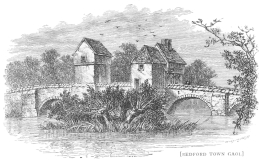 [BEDFORD TOWN GAOL
[BEDFORD TOWN GAOL
Sixth Thousand, demy 8vo, 7s. 6d.
JOHN BUNYAN
HIS LIFE, TIMES, AND WORK
By JOHN BROWN, D.D.
MINISTER OF THE BUNYAN MEETING, BEDFORD
With a Portrait, Facsimiles, and numerous Illustrations
“Dr. Brown is the first who has produced a biography of the
immortal dreamer, which is at the same time full, accurate, and
readable.”
Athenæum.
New and Cheap Edition, demy 8vo, 10s. 6d.
MARY HOWITT
An Autobiography
Edited by her Daughter, MARGARET HOWITT
With a Portrait and numerous Illustrations
“One of the most companionable books of our time. There is a
nameless charm in holding converse with one who has lived in our
own world, and who can yet tell us how her mother met Dr. Johnson
and Miss Burney.”—Academy.
{229}
New and Cheap Edition, 2 vols. demy 8vo, 12s.
THE LIFE AND LETTERS OF
THOMAS KEN
BISHOP OF BATH AND WELLS
AUTHOR OF “THE MORNING AND EVENING HYMNS,” ETC.
By the late E. H. PLUMPTRE, D.D.
DEAN OF WELLS
With a Portrait and Numerous Illustrations
“A permanent contribution to English historical literature.”
Church Times.
“It is not surpassed in permanent value and interest by any
biography written in the present generation.”—Record.
“This is the final Life of Ken.”—Academy.
{230}
Medium 8vo, gilt edges, 5s. With numerous Illustrations
THE PINCH OF POVERTY
Sufferings and Heroism of the London Poor
By “THE RIVERSIDE VISITOR”


“This book is not obtrusively didactic. Few or none would suspect
that they are being taught, but at the close of every chapter there
lingers in the mind some mighty lesson.... No person can read a
single page without being touched to finer issues. There is much
that is very beautiful, much that is very pathetic, but more that
must stir every right-minded man or woman to good works and to
prayer.”
Review of the Churches.
“We offer a hearty welcome to this book.... It is the work of one
whose experience has been long, and knowledge intimate, and whose
eye is as keen as his heart is kind. It should correct some current
misapprehensions, and provoke many a reader to good works.... It is
interesting from the first page to the last.”—Record.
“No attempt is made to deepen the shadows in these pictures of real
life, and we are not less glad to find that a book so wholesome and
manly, is not weakened by the intrusion of sickly sentiment or
highly-coloured rhetoric.”
The Speaker.
“The Riverside Visitor has the rare faculty of a real sympathy; he
enters into the trials and troubles of the poor as though he were
one of them, and gives us a very living and true picture of the
struggling multitudes, in whose well-being he is so keenly
interested.”—Modern Church.
{231}
Large crown 8vo, 3s. 6d.
French Morocco, red-gilt edges, 5s. net.
IN THE FOOTSTEPS OF THE POETS
Biographical, Critical, and Topographical Studies
WITH NEARLY 100 ILLUSTRATIONS
CONTENTS.
| 1. MILTON. By Professor David Masson, LL.D. |
| 2. HERBERT. By John Brown, D.D. (Bedford). |
| 3. COWPER. By the Rev. Canon Benham, B.D. |
| 4. THOMSON. By Hugh Haliburton. |
| 5. WORDSWORTH. By Henry C. Ewart. |
| 6. SCOTT. By John Dennis. |
| 7. MRS. BROWNING. By the Bishop of Ripon. |
| 8. ROBERT BROWNING. By R. H. Hutton. |
| 9. TENNYSON. By William Canton. |
“An acceptable addition to any drawing-room table.... Some of the
illustrations are very charming.”—St. James’s Gazette.
“A truly delightful book.”—Lady.
{232}
Large crown 8vo, 3s. 6d.
French Morocco, red gilt-edges, 5s. net.
OUR ENGLISH MINSTERS
With 100 Illustrations by Herbert Railton
CONTENTS
| 1. WESTMINSTER ABBEY. By Archdeacon Farrar, D.D. |
| 2. CANTERBURY CATHEDRAL. By the Hon. Canon Fremantle, M.A. |
| 3. DURHAM CATHEDRAL. By Canon Talbot, M.A. |
| 4. WELLS CATHEDRAL. By S. M. J. Pereira. |
| 5. LINCOLN CATHEDRAL. By Precentor Venables, M.A. |
| 6. WINCHESTER CATHEDRAL. By Canon Benham, B.D. |
| 7. GLOUCESTER CATHEDRAL. By the Dean of Gloucester. |
“Attractive and well-illustrated accounts, historical and
architectural, by competent hands, of seven English
Minsters.”—Times.
“Charmingly got up ... one of the best-gift books of the season.”
British Weekly.
ISBISTER & CO. LTD., 15 & 16 TAVISTOCK ST., COVENT GARDEN, LONDON{233}

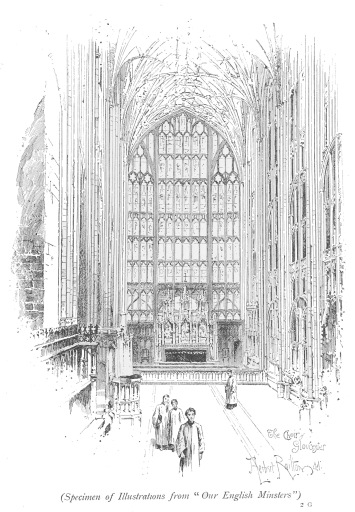 (Specimen of Illustrations from “Our English
Minsters”)
(Specimen of Illustrations from “Our English
Minsters”)
{234}

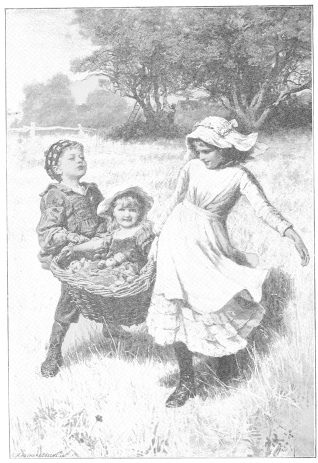 (By permission of the Berlin Photographic Co., 133 New
Bond Street, London)
(By permission of the Berlin Photographic Co., 133 New
Bond Street, London)
(Specimen of Illustrations from “Sunday Magazine”, 1894)
{235}
Royal 8vo, gilt edges, 7s. 6d.
THE
SUNDAY MAGAZINE VOLUME
1894
Edited by the Rev. BENJAMIN WAUGH
AUTHOR OF
“Sunday Evenings with My Children,” &c.
and containing
ANNIE S. SWAN’S New Three-volume Story
A LOST IDEAL
AND ARTICLES BY
- Archdeacon Farrar, D.D.
- Precentor Venables, M.A.
- Professor J. P. Mahaffy, D.D.
- Canon Atkinson, D.C.L.
- Rev. Professor H. C. Shuttleworth, M.A.
- Julia Wedgwood.
- Canon T. Teignmouth Shore, M.A.
- L. T. Meade.
- Professor W. T. Gairdner, M.D.
- Wm. Wright, D.D.
- Canon Liddell, M.A.
- J. Monro Gibson, D.D.
- R. F. Horton, D.D.
- Professor T. M. Lindsay, D.D.
- G. F. Pentecost, D.D.
- The Editor.
And other well-known writers
With Twelve Coloured Plates
AND OVER 300 ILLUSTRATIONS BY
- G. F. Watts, R.A.
- Sir E. Burne-Jones.
- Fred Morgan.
- F. G. Kitton.
- C. E. Brock.
- C. W. Wyllie.
- A. S. Boyd.
- &c. &c.
“Admirably artistic.”—Times.
“No magazine for Sunday reading so good.”—Spectator.
“Full of good reading and capital pictures.”—Daily Telegraph.
{236}
Royal 8vo, gilt edges, 7s. 6d.
GOOD WORDS VOLUME
1894
Edited by DONALD MACLEOD, D.D.
ONE OF H.M. CHAPLAINS
and containing
S. BARING GOULD’S New Three-volume Story
KITTY ALONE
SHORT STORIES BY
- BRET HARTE
- W. E. NORRIS
- L. B. WALFORD
- W. CLARK RUSSELL
- LANOE FALCONER
- And others
AND ARTICLES BY
- The Bishop of Winchester.
- Sir R. S. Ball, Ll.D.
- Sir Herbert Maxwell, M.P.
- The Dean of York.
- Sir Wm. H. Flower, Ll.D.
- The Dean of Gloucester.
- Archdeacon Sinclair, D.D.
- Justin McCarthy, M.P.
- “Shirley.”
- John Hunter, D.D.
- George Matheson, D.D.
- Katharine Hinkson.
- William Canton.
- Augustus Jessopp, D.D.
- The Editor, &c. &c.
WITH OVER 300 ILLUSTRATIONS BY
- Gordon Browne.
- Alex. Ansted.
- Lockhart Bogle.
- W. H. Overend.
- A. J. Goodman.
- Charles Whymper.
- F. H. Townsend.
- Herbert Railton.
- And others.
“‘Good Words’ is, if possible, better than ever.”—Daily
Telegraph.
“The latest volume is a specially attractive one.”—Times.
“Altogether, more than maintains its high reputation.”—Record.
ISBISTER & CO. LTD., 15 & 16 TAVISTOCK ST., COVENT GARDEN, LONDON{237}

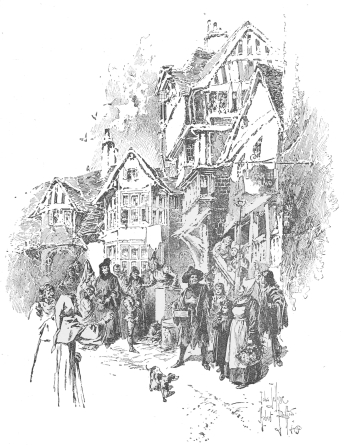 (Specimen of Illustrations from “Good Words,” 1894)
(Specimen of Illustrations from “Good Words,” 1894)
{238}

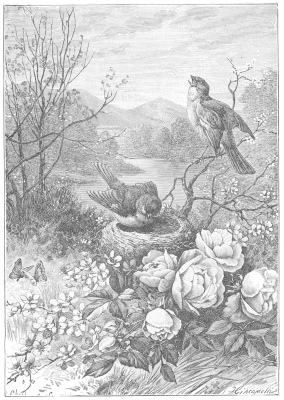 “Each little flower that opens,
Each little bird that sings.”
“Each little flower that opens,
Each little bird that sings.”
(Specimen of Illustrations from “Sunday Evenings with My Children”)
{239}
Thirteenth Thousand, square 8vo, 6s. 6d.
SUNDAY EVENINGS
WITH MY CHILDREN
A Book of Services for the Young
By the Rev. BENJAMIN WAUGH
Editor of “The Sunday Magazine,” &c.
With 100 Illustrations
“Is par excellence the book for a mother’s Sunday evenings with
her children.”—Christian.
“A beautiful volume, sure to captivate the young intellect and
heart.”
Homilist.
“We especially commend it to the notice of all parents or teachers
who have to conduct in any form children’s
services.”—Schoolmaster.
BY THE SAME AUTHOR
Sixth Thousand, square 8vo, 5s.
THE CHILDREN’S SUNDAY HOUR
With nearly 100 Illustrations
“It is more than a pleasure, it is almost a duty, to recommend this
admirable volume to the consideration of parents and all those who
teach the young.”—Spectator.
“Of much external beauty, and well written. A book handsome in
itself, and in all respects calculated to please the young people
for whom it is intended.”—Scotsman.
ISBISTER & CO. LTD., 15 & 16 TAVISTOCK ST., COVENT GARDEN, LONDON{240}
Two Vols. medium 8vo, 21s. each
THE COMMEDIA AND CANZONIERE
OF DANTE ALIGHIERI
A New Translation
WITH BIOGRAPHICAL INTRODUCTION, AND NOTES CRITICAL
AND HISTORICAL
AND TWO PORTRAITS
By E. H. PLUMPTRE, D.D., Dean of Wells
Volume I. Life. Hell, Purgatory.
Volume II. Paradise, Minor Poems. Studies:
The Genesis and Growth of the Commedia. Estimates of Dante. Dante
as an Observer and Traveller. Portraits of Dante, &c.
The Spectator says:—“No man aiming at literary reputation can
think his education complete unless he studies Dante, in
translations or in the original. No book about Dante has been
published in England that will stand comparison with Dean
Plumptre’s. He deserves the gratitude of all true lovers of good
literature for writing it. We have nothing further to say of it
except that, take it for all in all, the only fitting epithet we
can find for it is ‘noble’; and that we do most heartily wish it
all the success which it richly deserves.”
The Saturday Review says:—“The Dean of Wells may be
congratulated upon the completion of his labour of love.... In the
English rendering of the Paradiso, as well as in the notes to
that portion of the poem, the Dean’s profound and intimate
acquaintance with the theology of the Middle Ages has given him a
great advantage over other translators and commentators.... For
students of Dante, the ‘Studies’ will be found most valuable and
interesting. A large quantity of material has been collected and
arranged as it only could have been by one thoroughly conversant
with his subject, and giving his best abilities and affections to
the accomplishment of his work.”
The Record says:—“Conceived in the lofty and generous spirit of
a true scholar. Nowhere will the cultivated English Christian find
so much help as this work will give him in understanding and
enjoying the message of Dante to men. The second volume deepens the
impression made by the first. The parts interlace as well as
complete each other; the volumes are two, the book is one. The Dean
‘stands on his achievement.’ It is no unworthy pedestal.”
The Academy says:—“The whole work is a monument of many years’
devoted study; it is illustrated throughout by an unusual range of
reading and culture in other fields of literature; and it is
accompanied by a most copious and valuable index of subjects and
names.”
ISBISTER & CO. LTD., 15 & 16 TAVISTOCK ST., COVENT GARDEN, LONDON
Printed by Ballantyne, Hanson & Co., London & Edinburgh.{241}
*** END OF THE PROJECT GUTENBERG EBOOK 47191 ***
![]() will bring up a larger version of the illustration.
will bring up a larger version of the illustration.

 IF we had to distribute the Seasons among the birds that
are called “British,” selecting a notable fowl to represent each, we
could hardly overlook the claims of the cuckoo, the nightingale, and the
swallow to distinction. But, after all, these are not “thorough
Britons.” They only come to us for our summer, and when that goes they
follow it. Though great numbers of them are British-born, they are at
best only Anglo-Continental, Anglo-Asiatic, Anglo-African, and
Inter-Oceanic. But our resourceful little islands give us native birds,
all our own, that amply serve the Seasons, and represent, with sufficing
charm, the
IF we had to distribute the Seasons among the birds that
are called “British,” selecting a notable fowl to represent each, we
could hardly overlook the claims of the cuckoo, the nightingale, and the
swallow to distinction. But, after all, these are not “thorough
Britons.” They only come to us for our summer, and when that goes they
follow it. Though great numbers of them are British-born, they are at
best only Anglo-Continental, Anglo-Asiatic, Anglo-African, and
Inter-Oceanic. But our resourceful little islands give us native birds,
all our own, that amply serve the Seasons, and represent, with sufficing
charm, the

















































